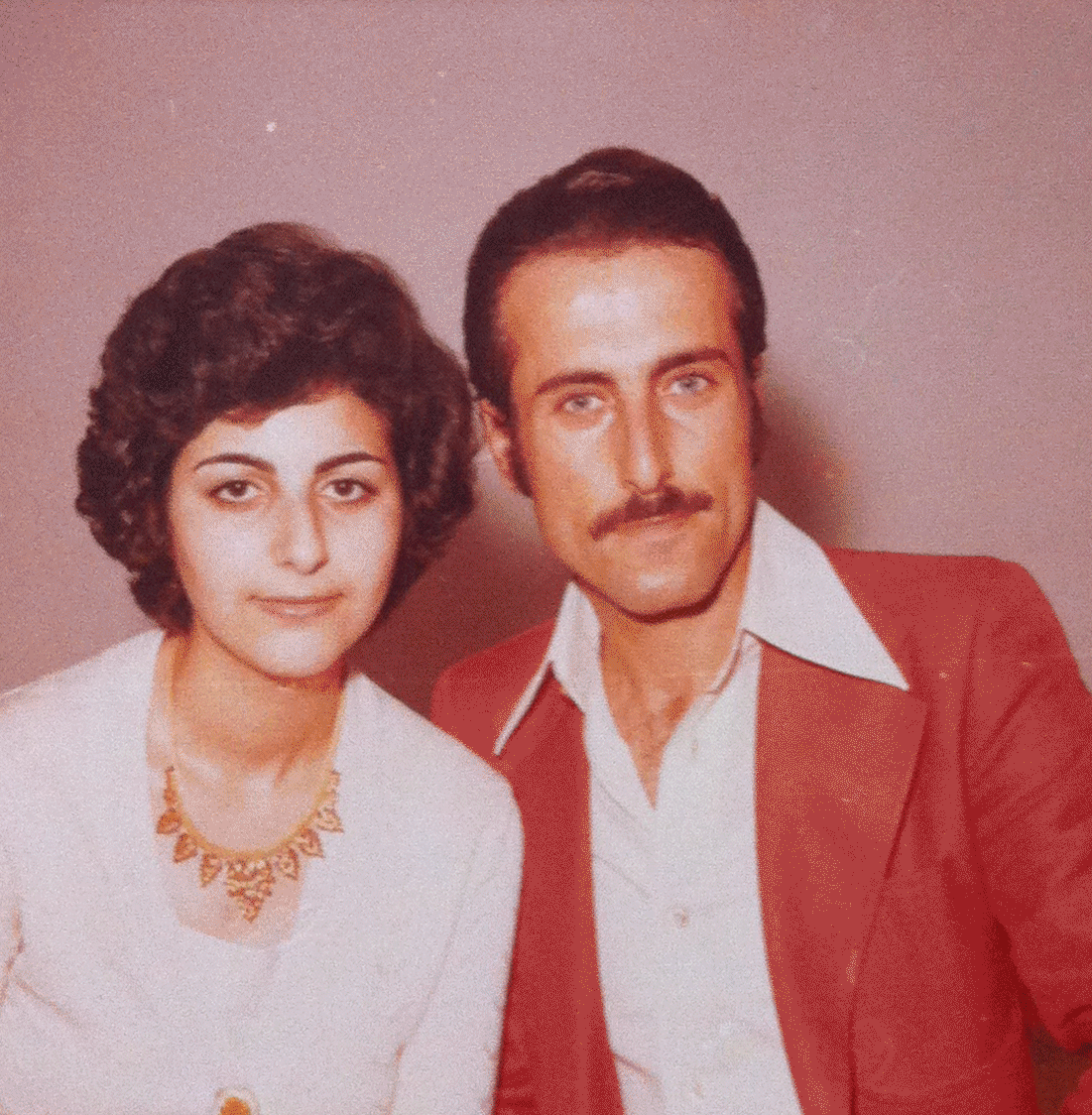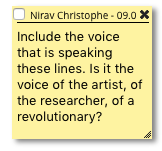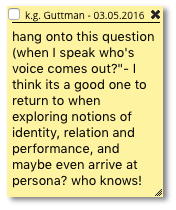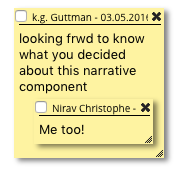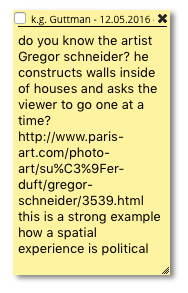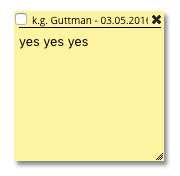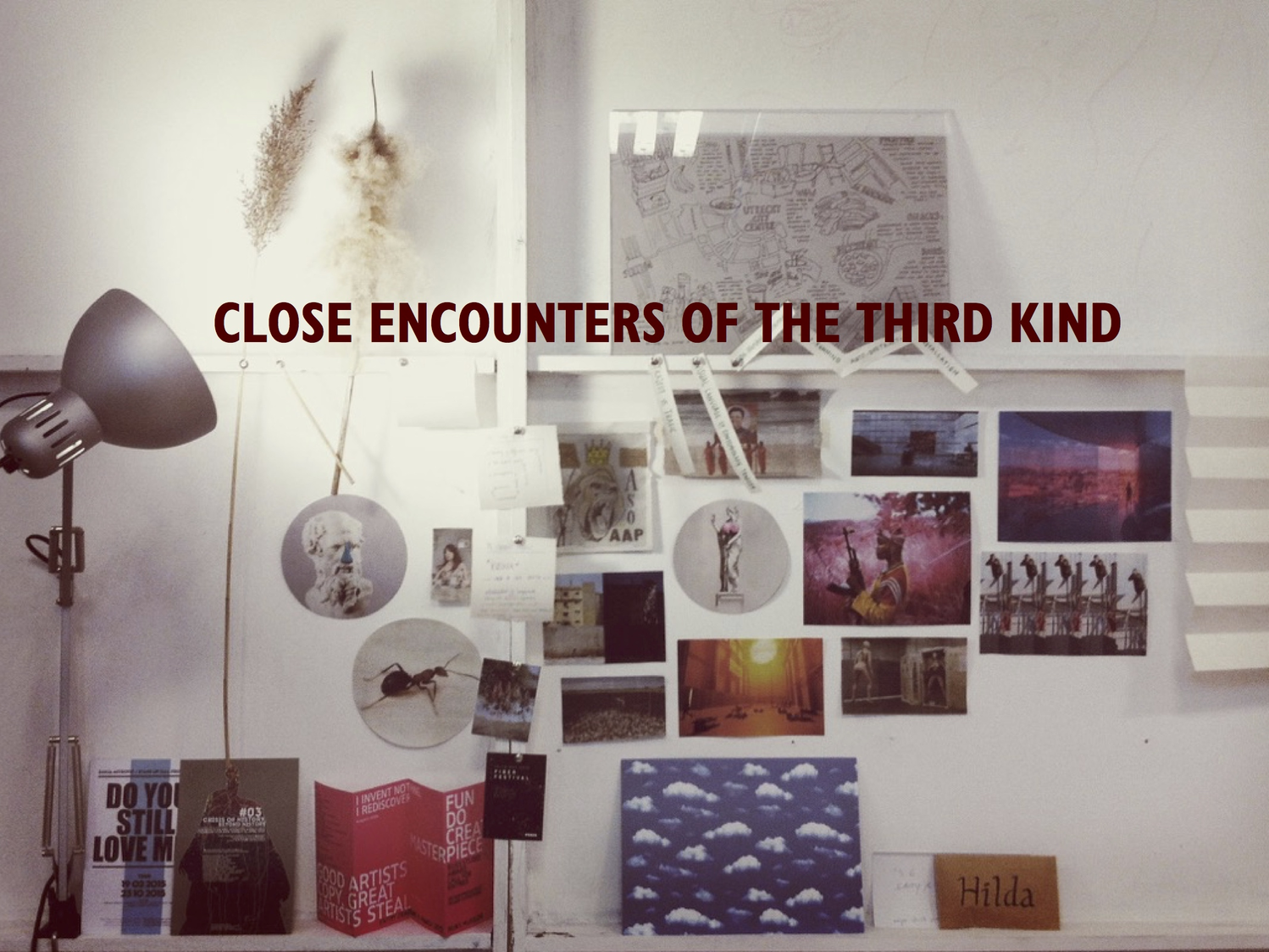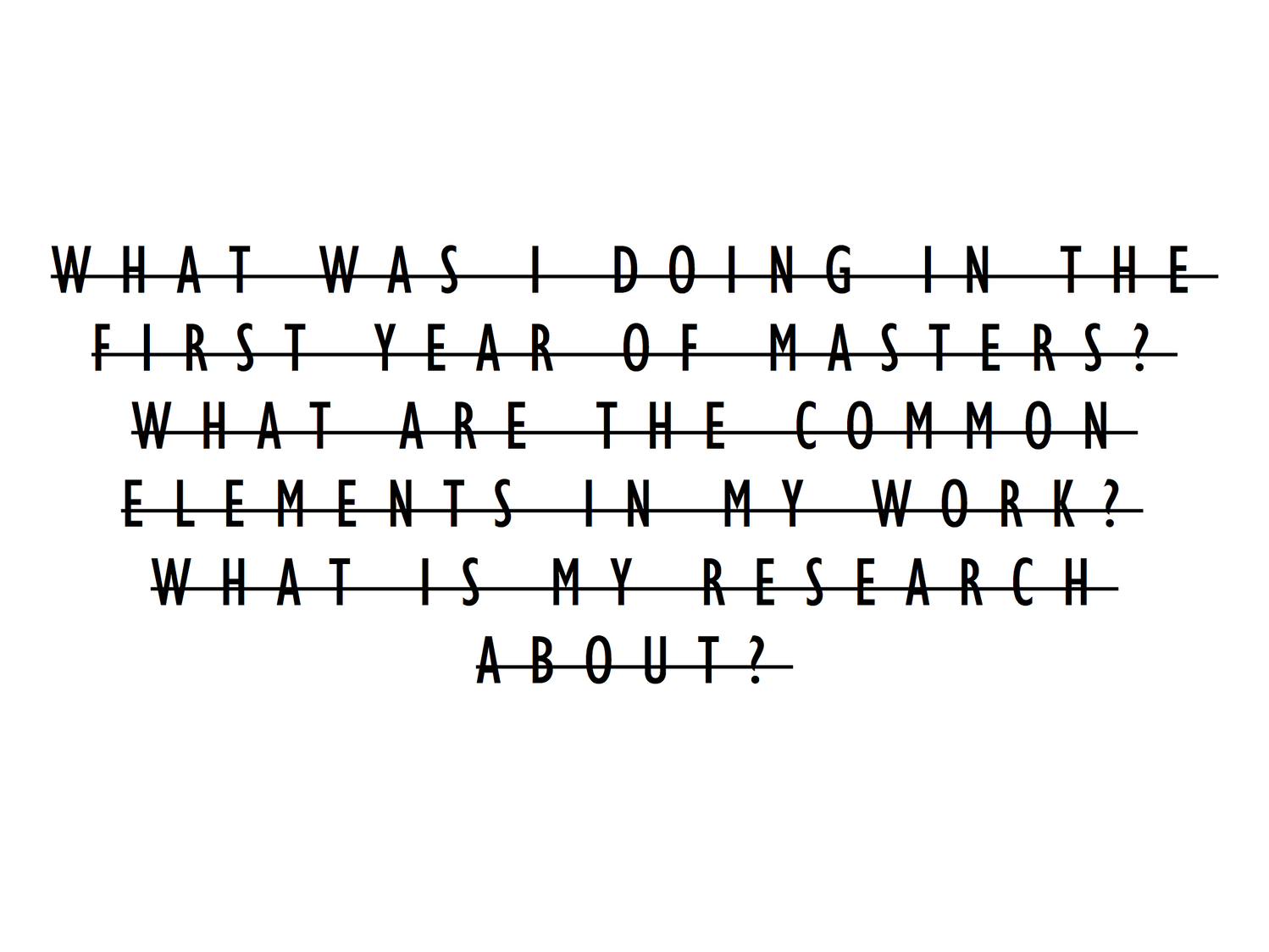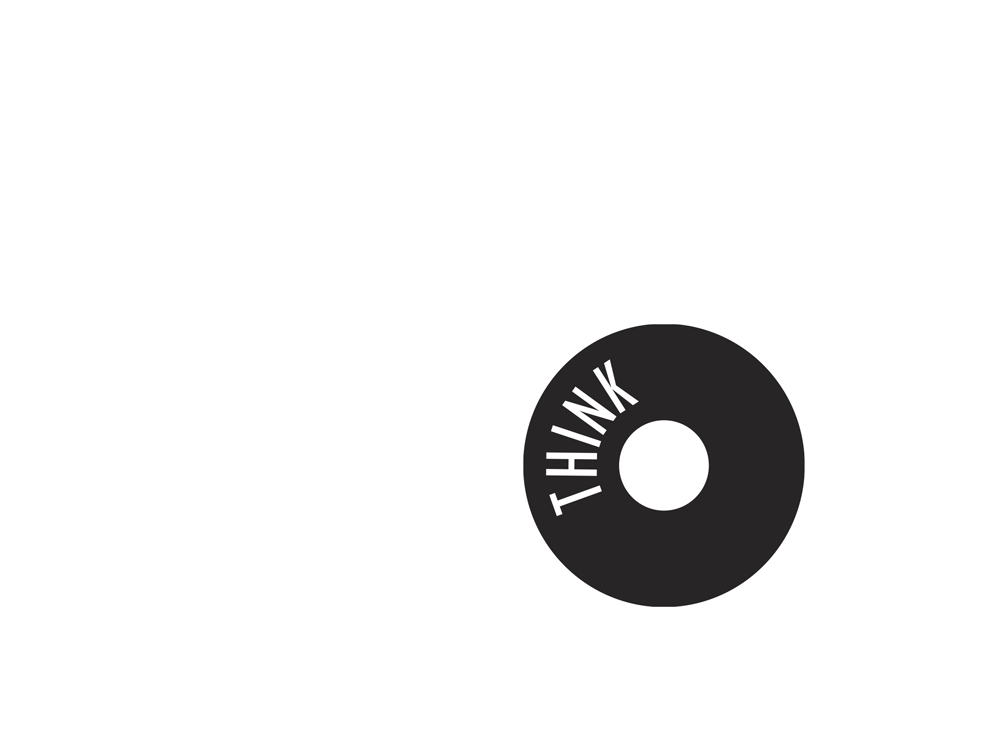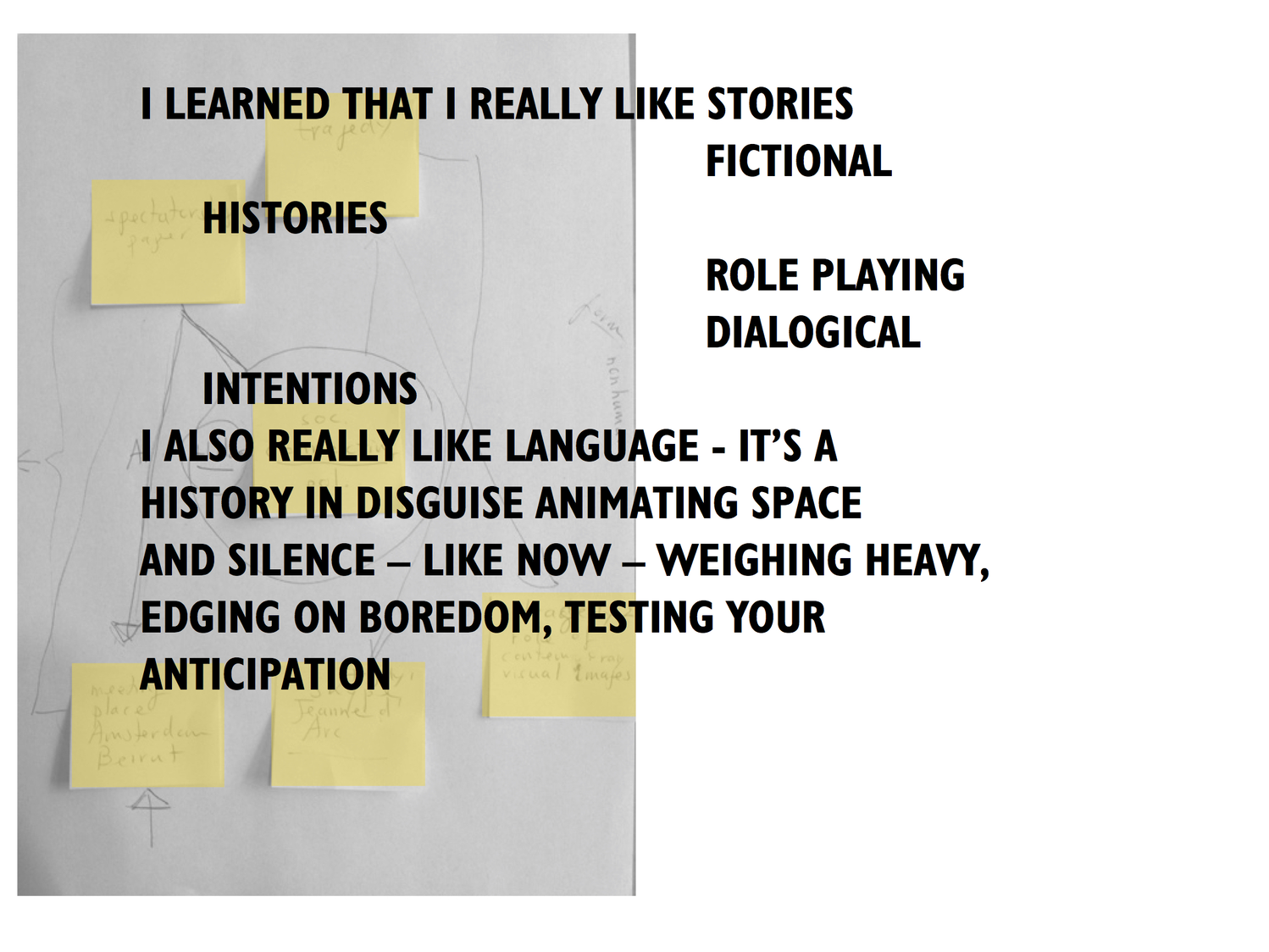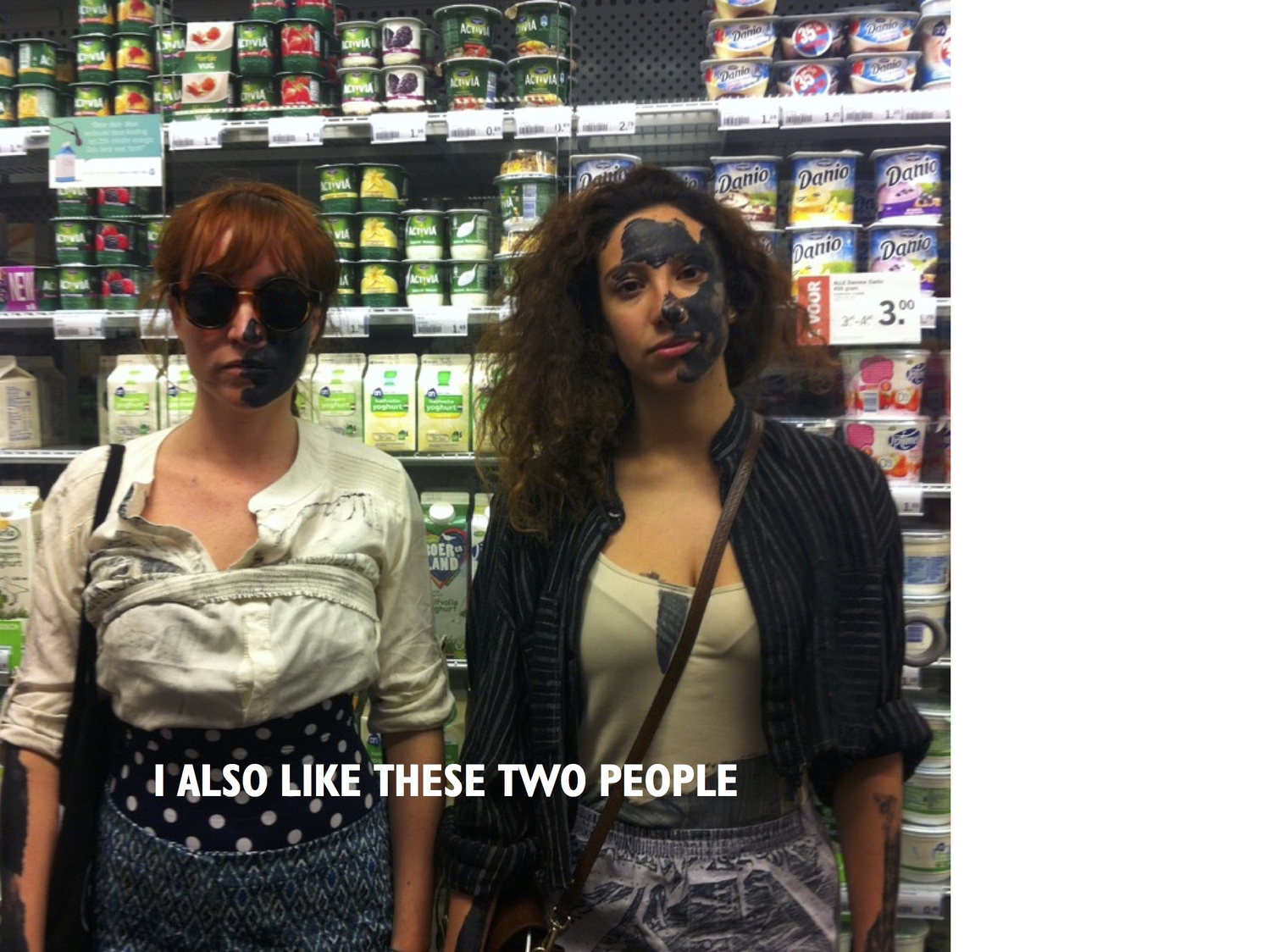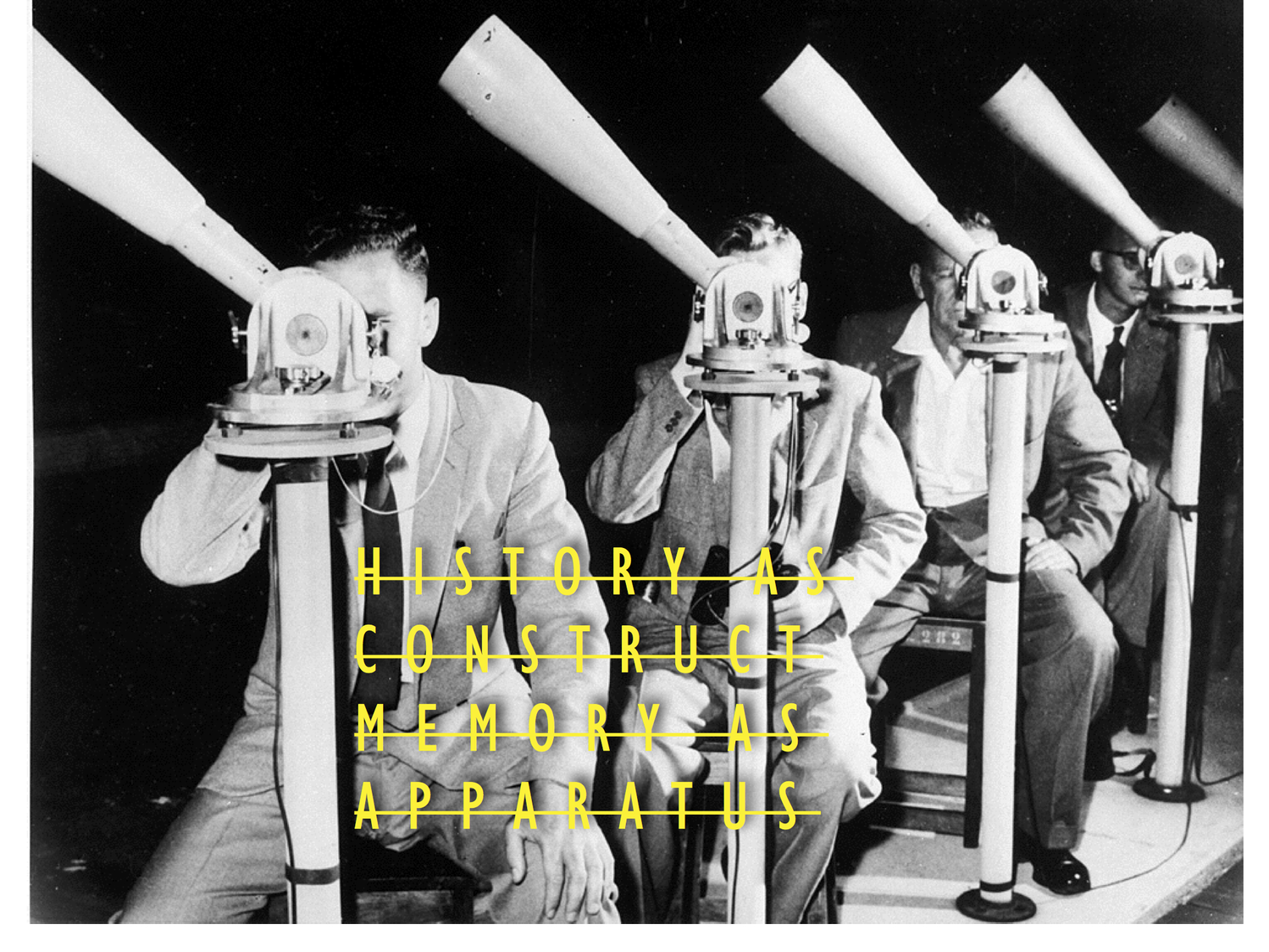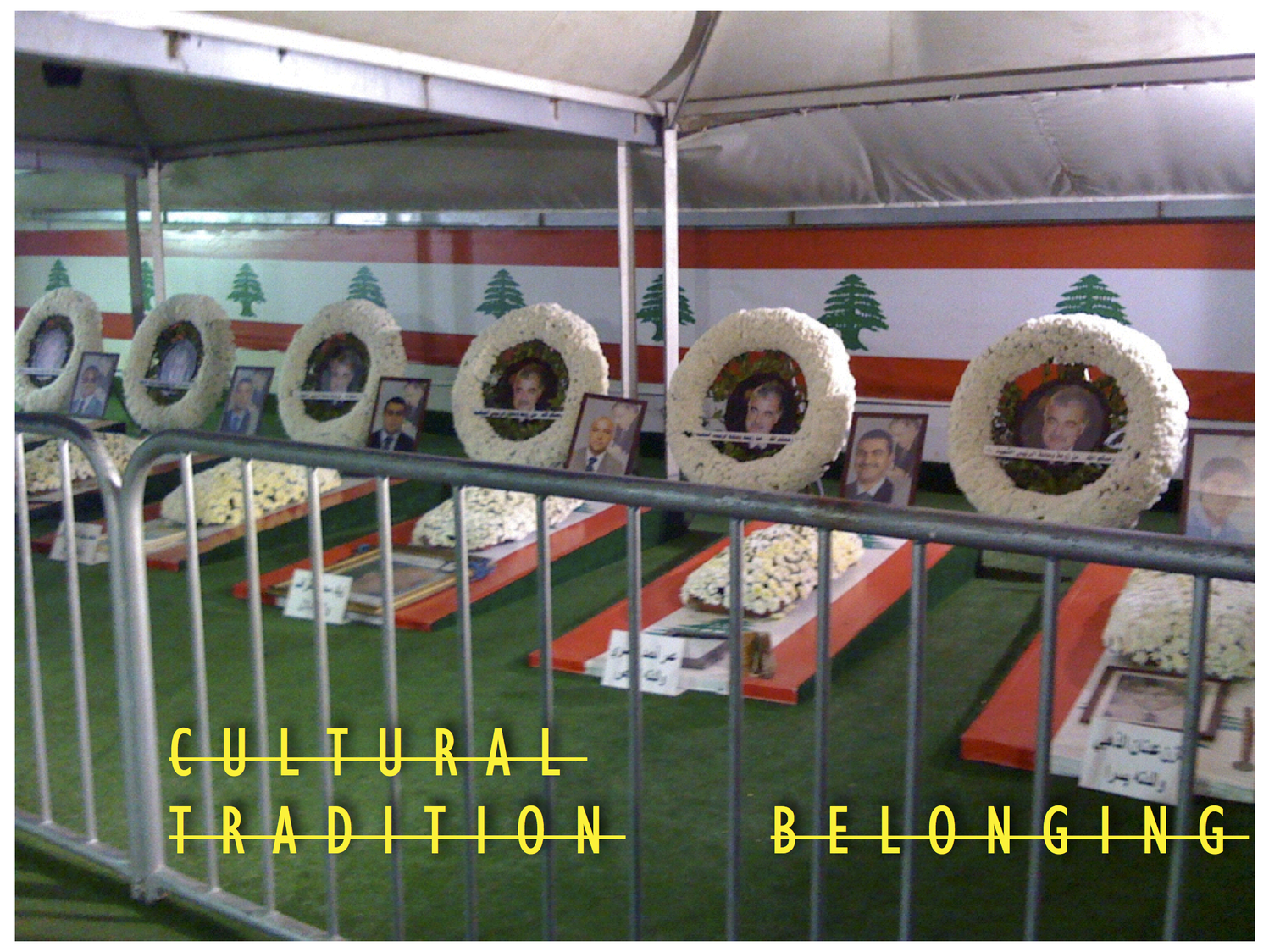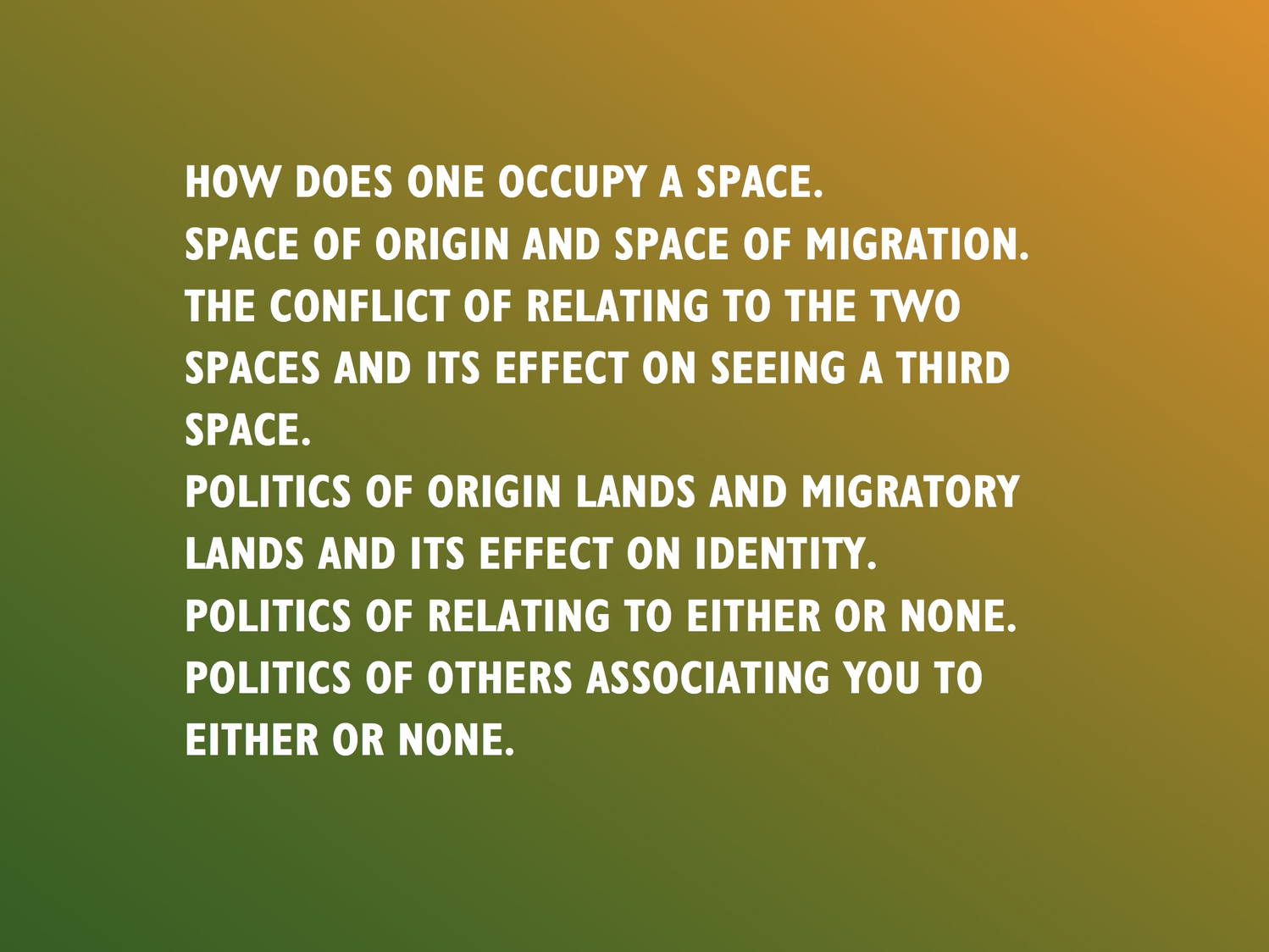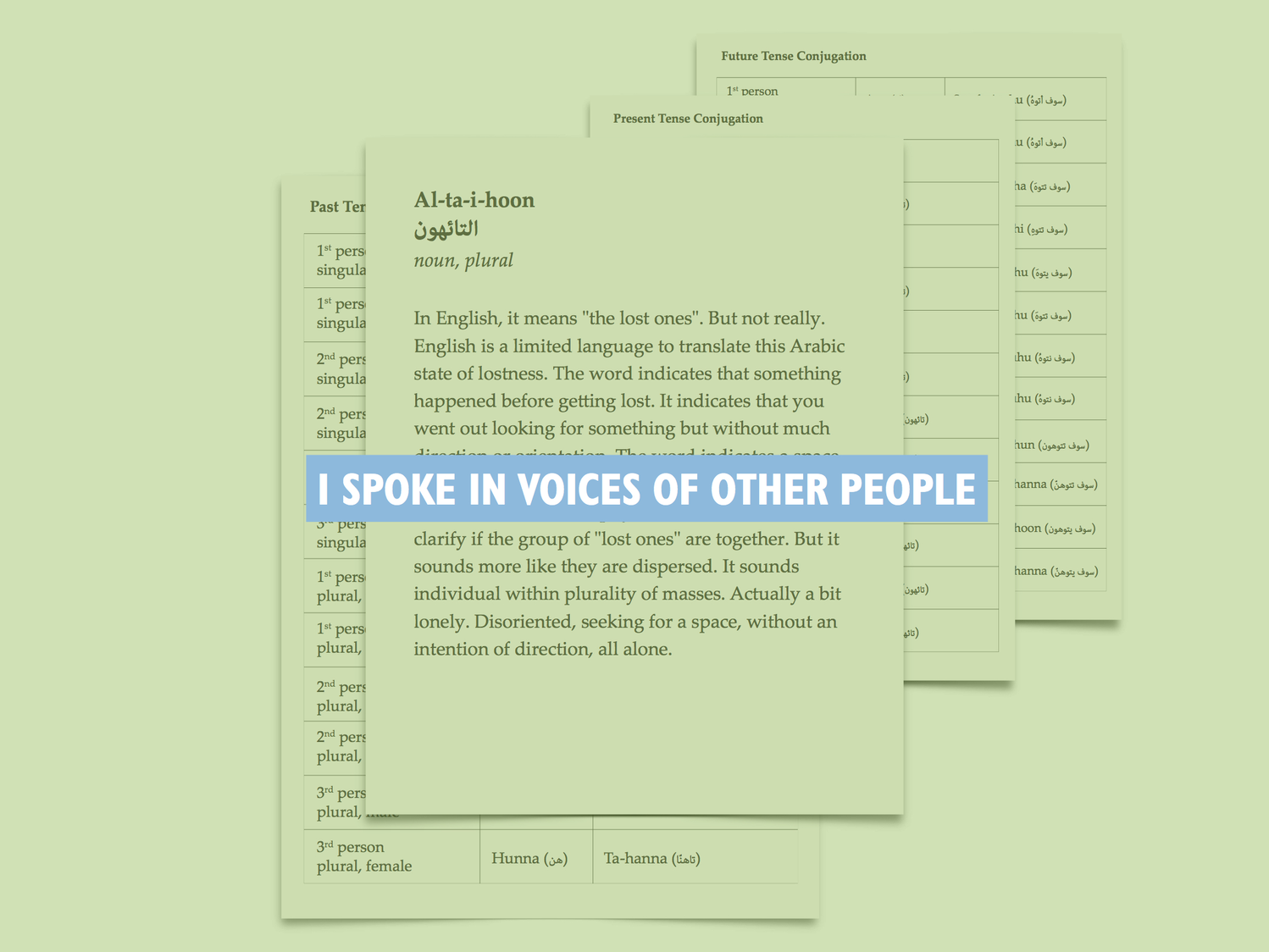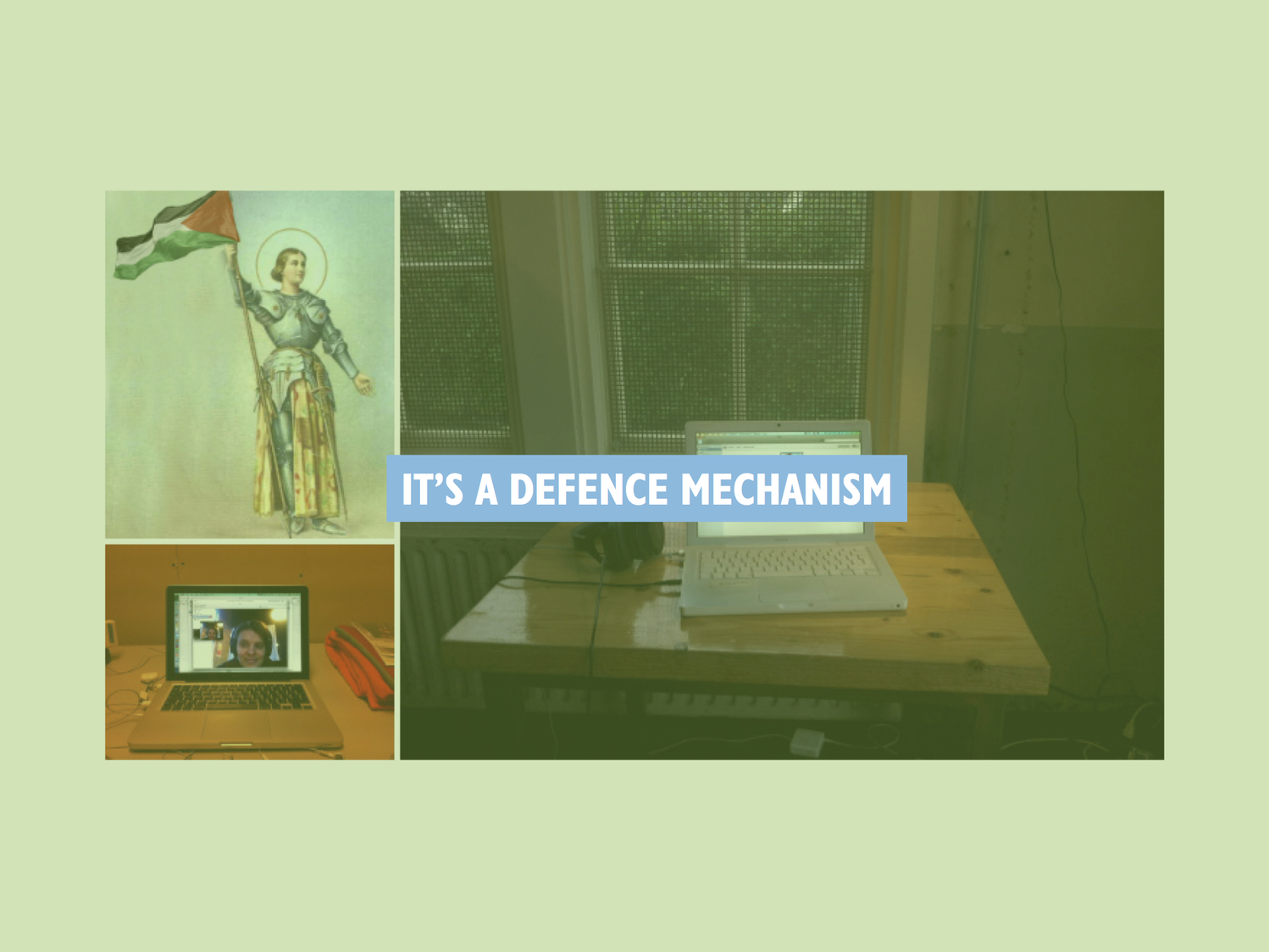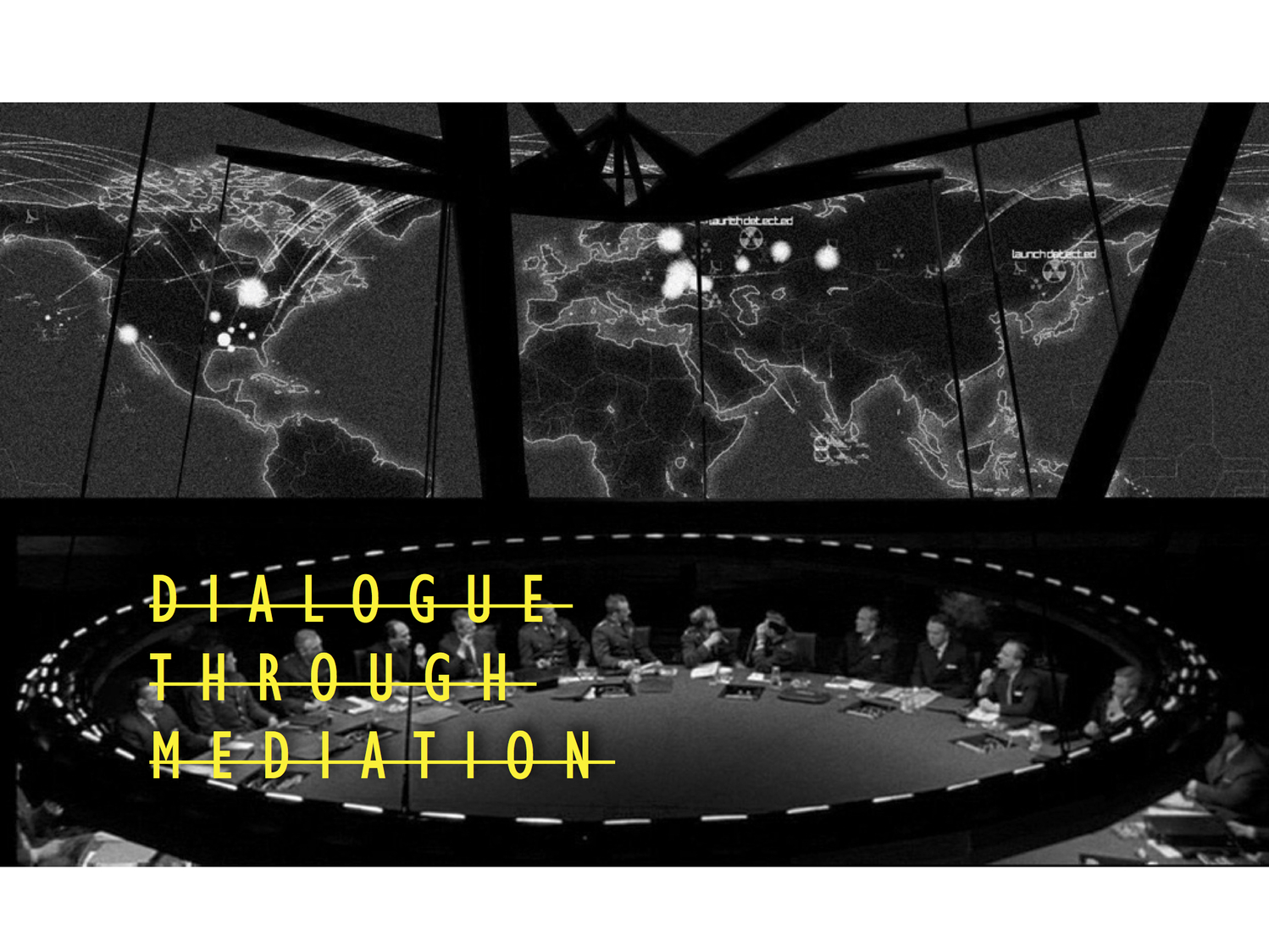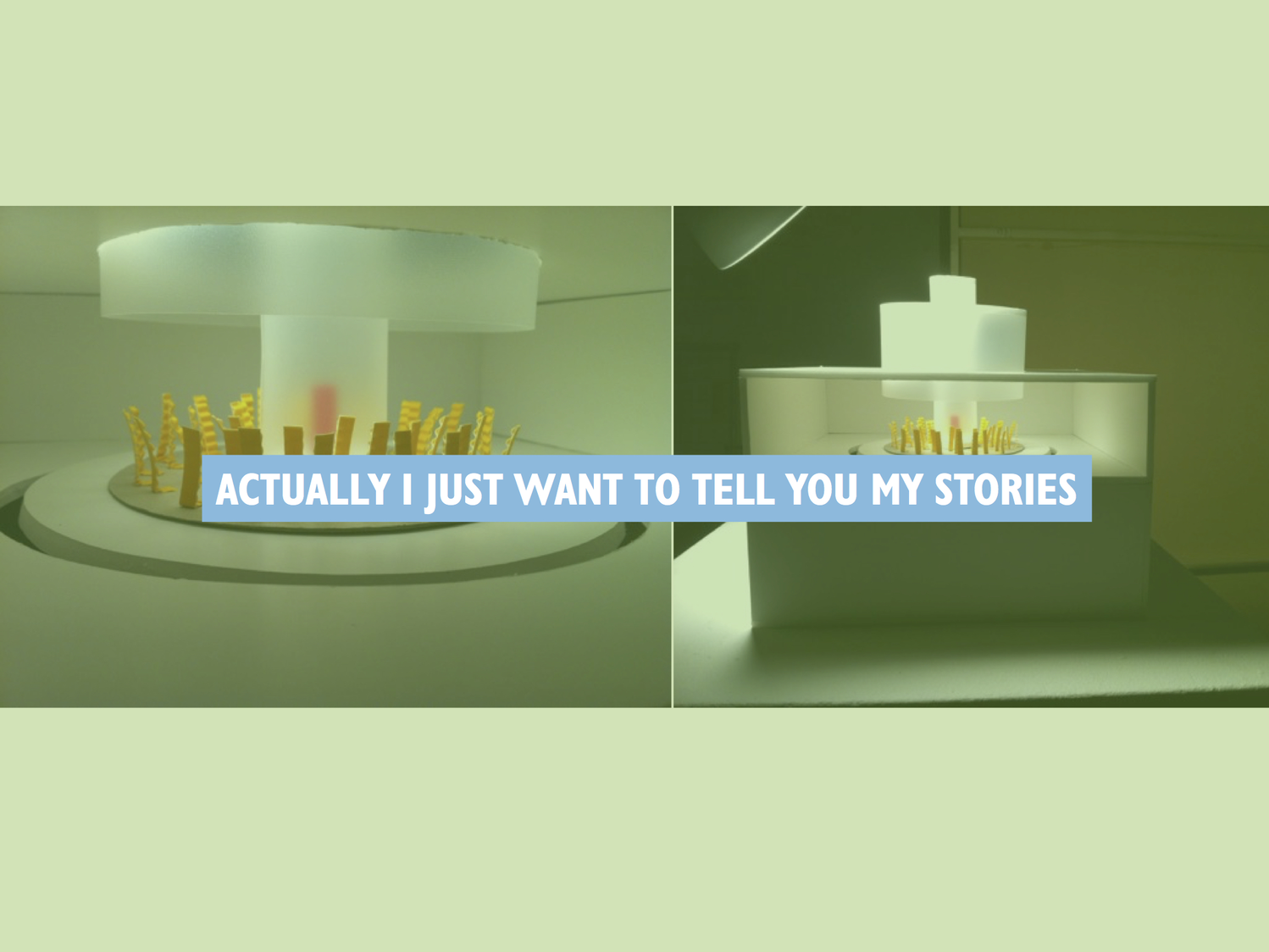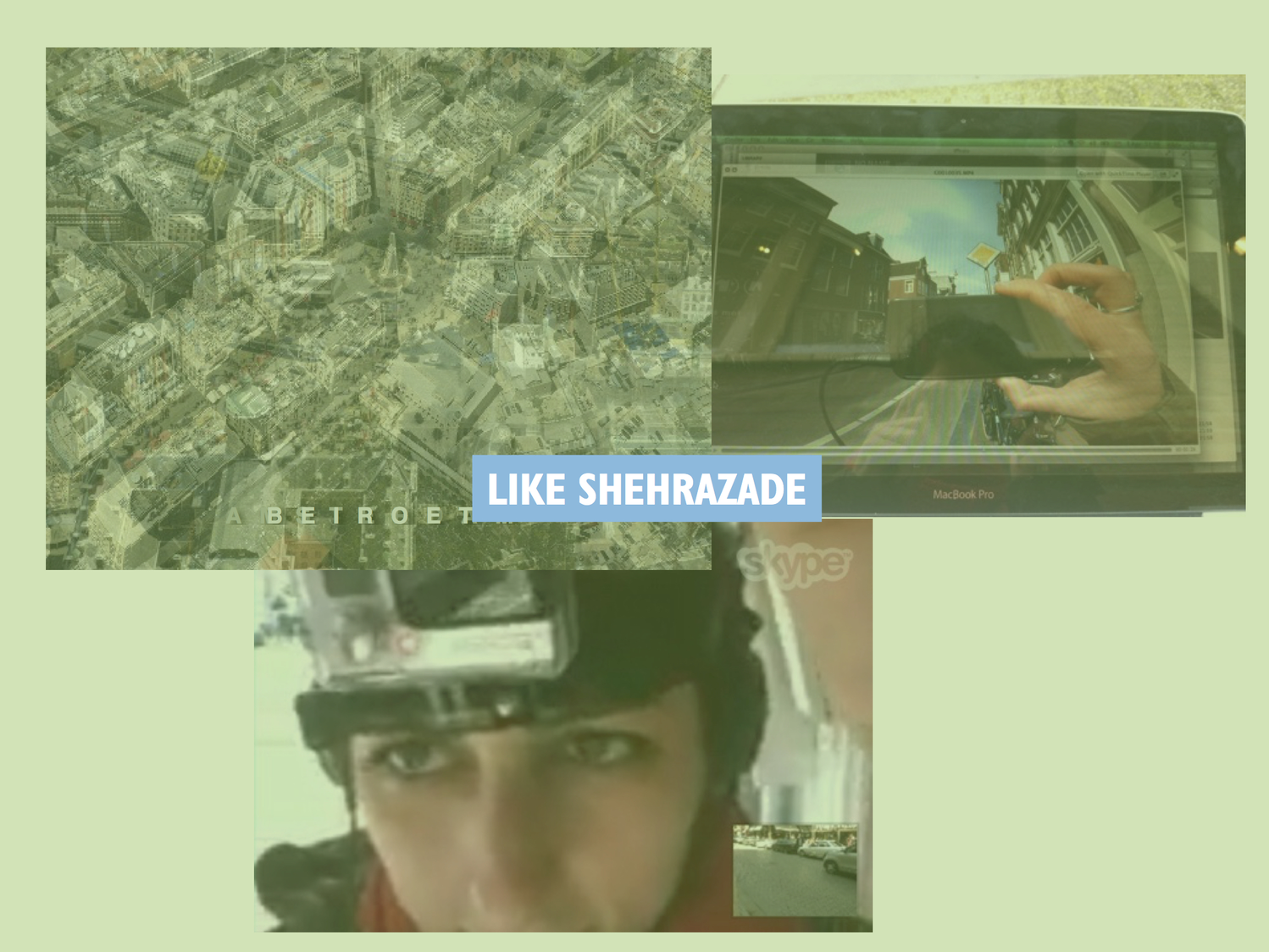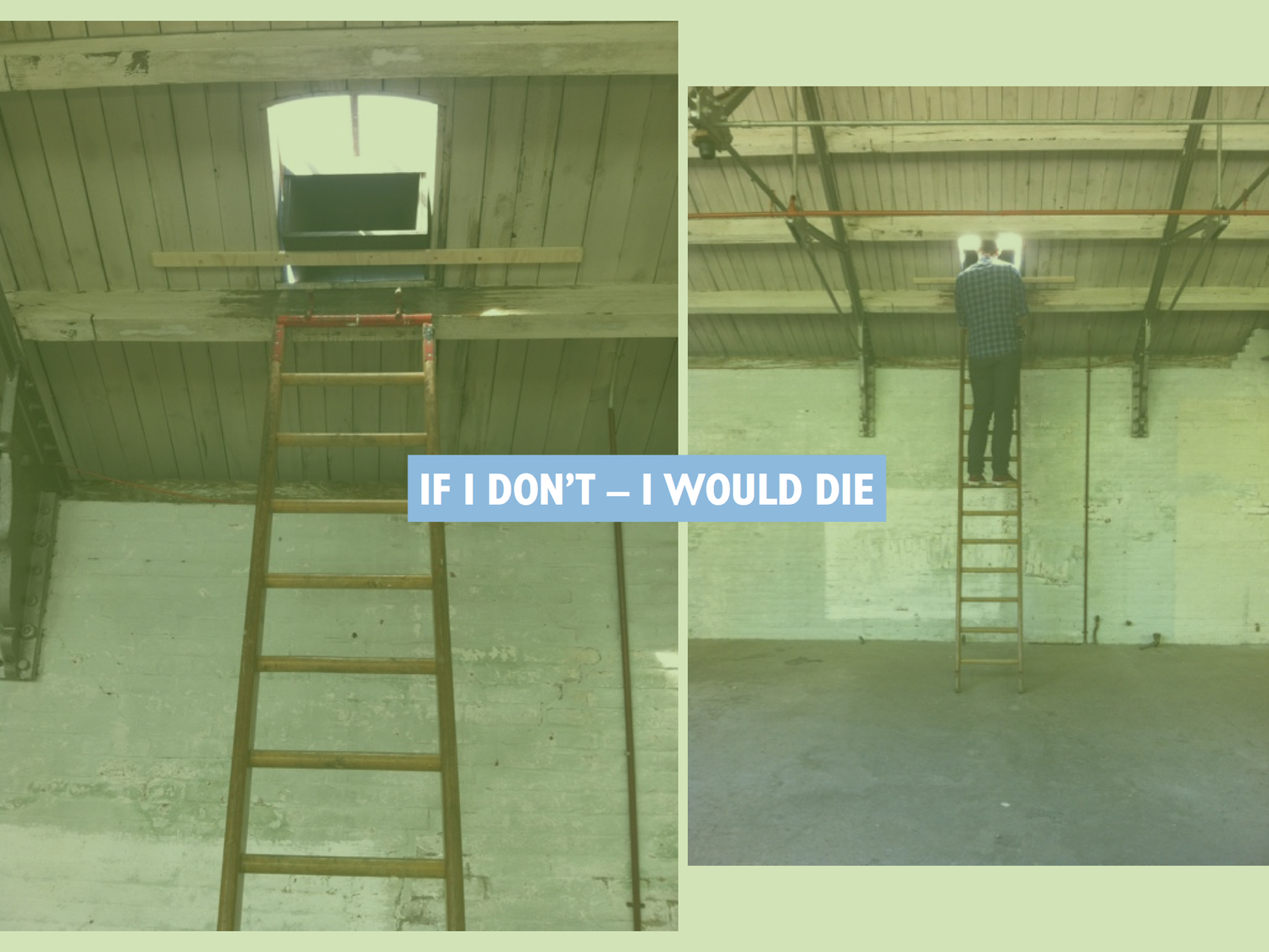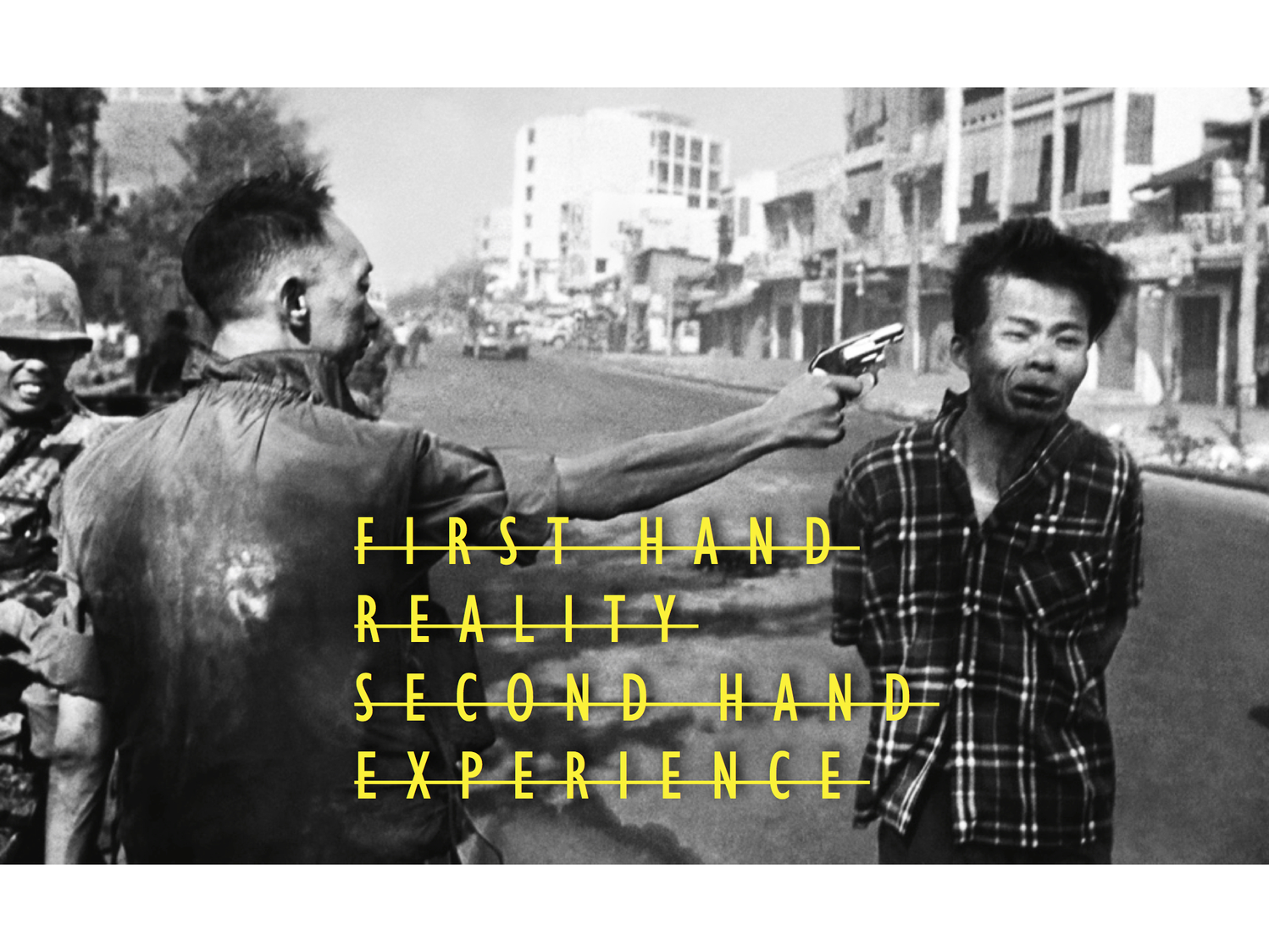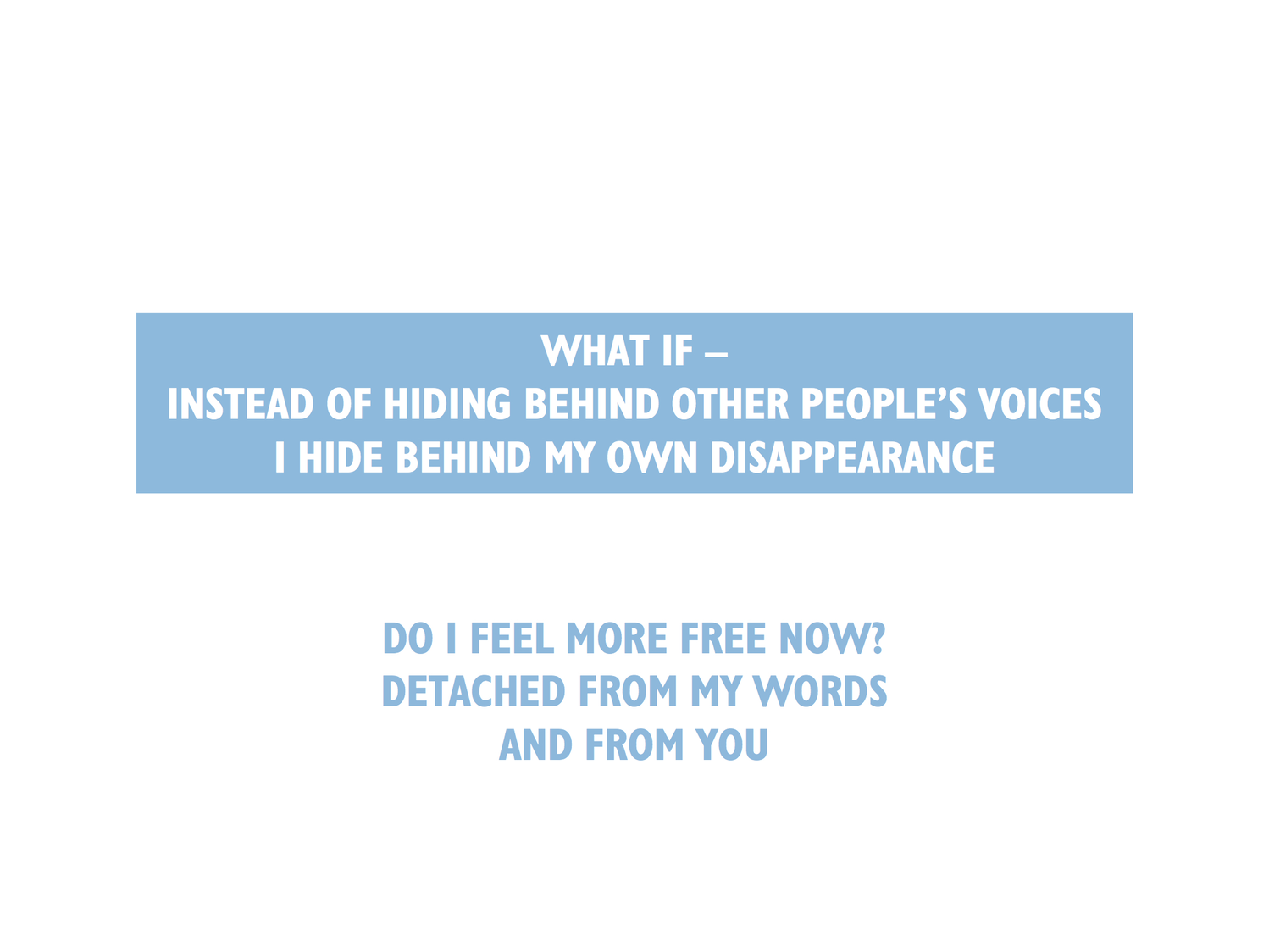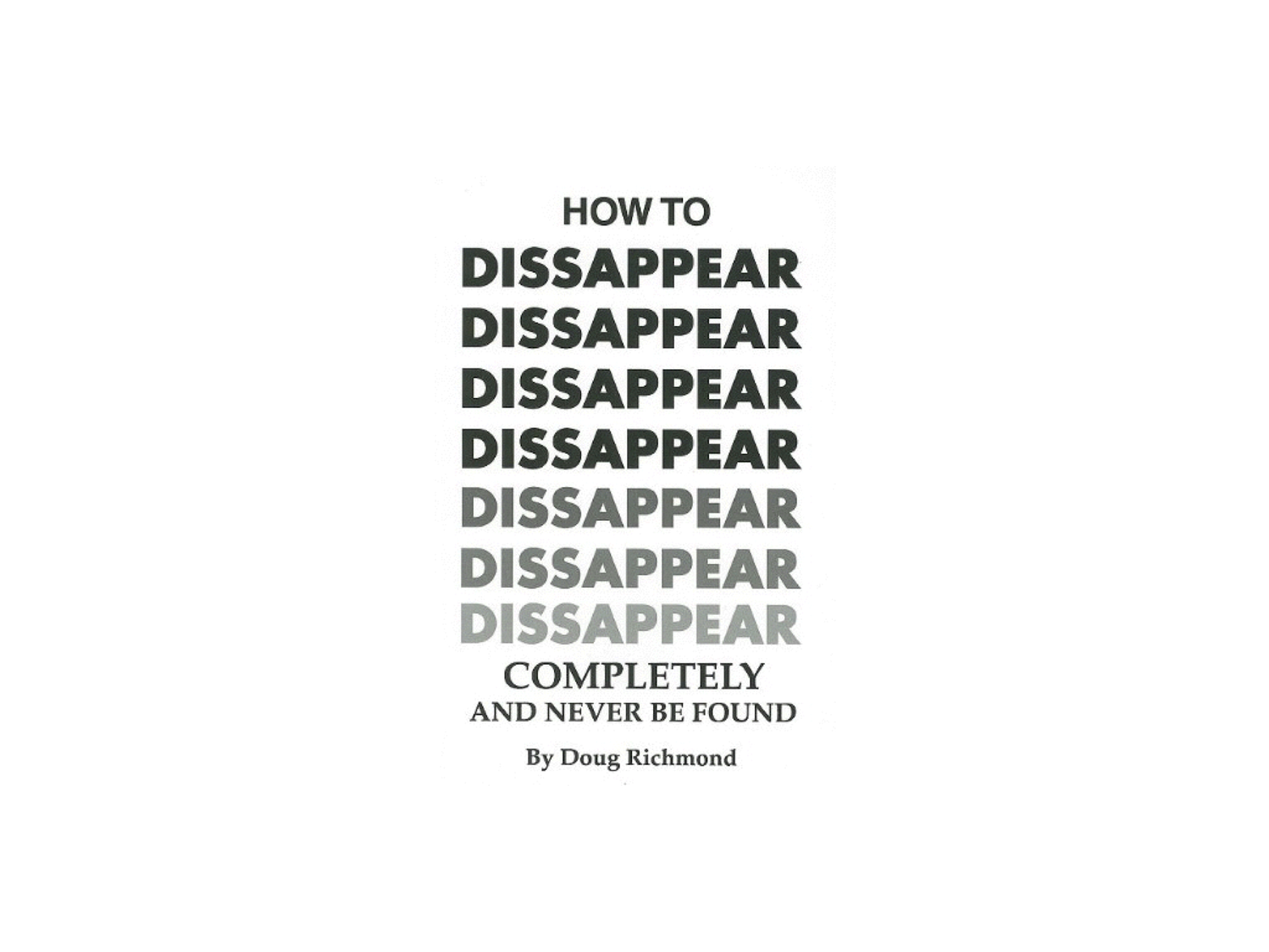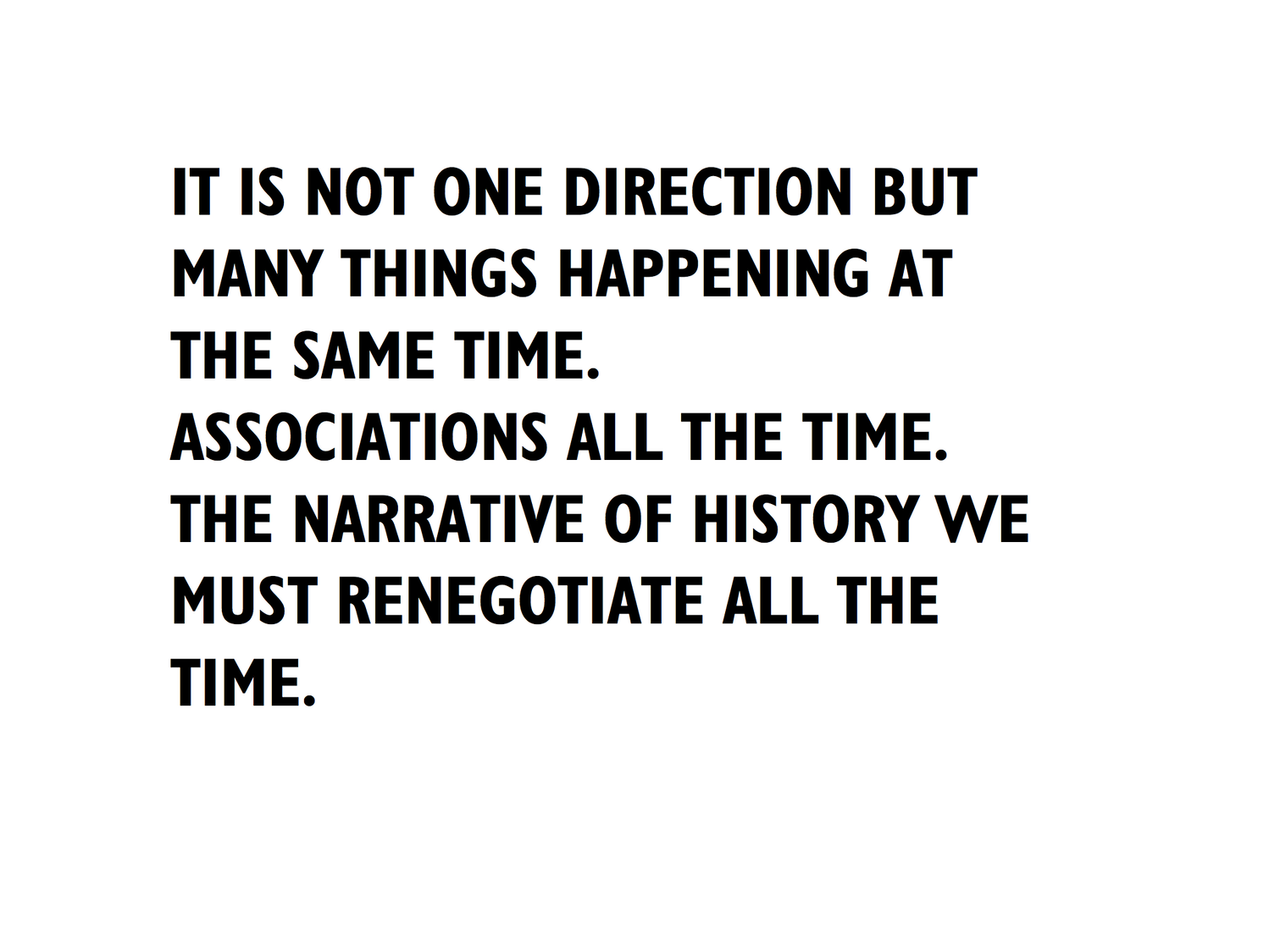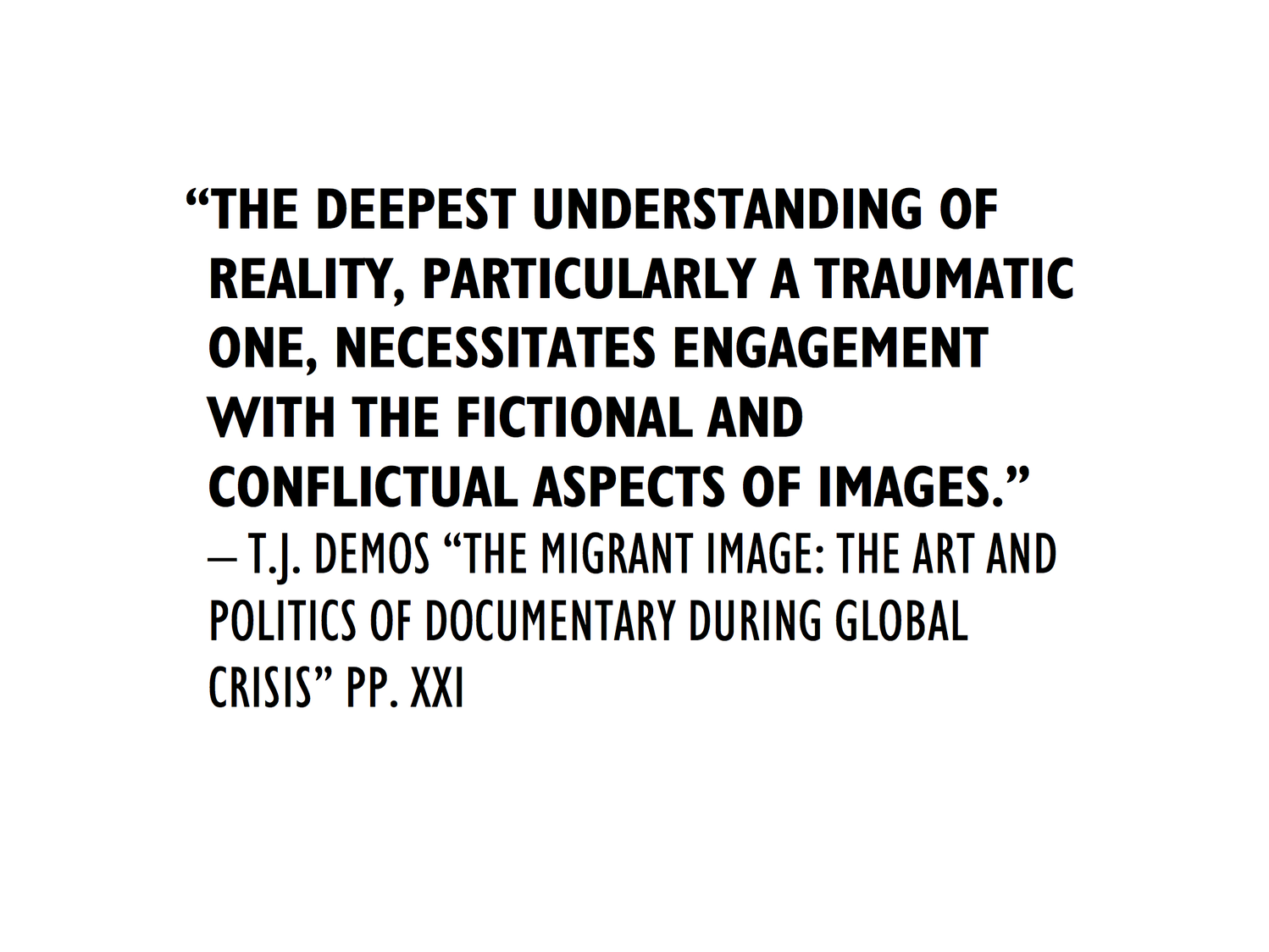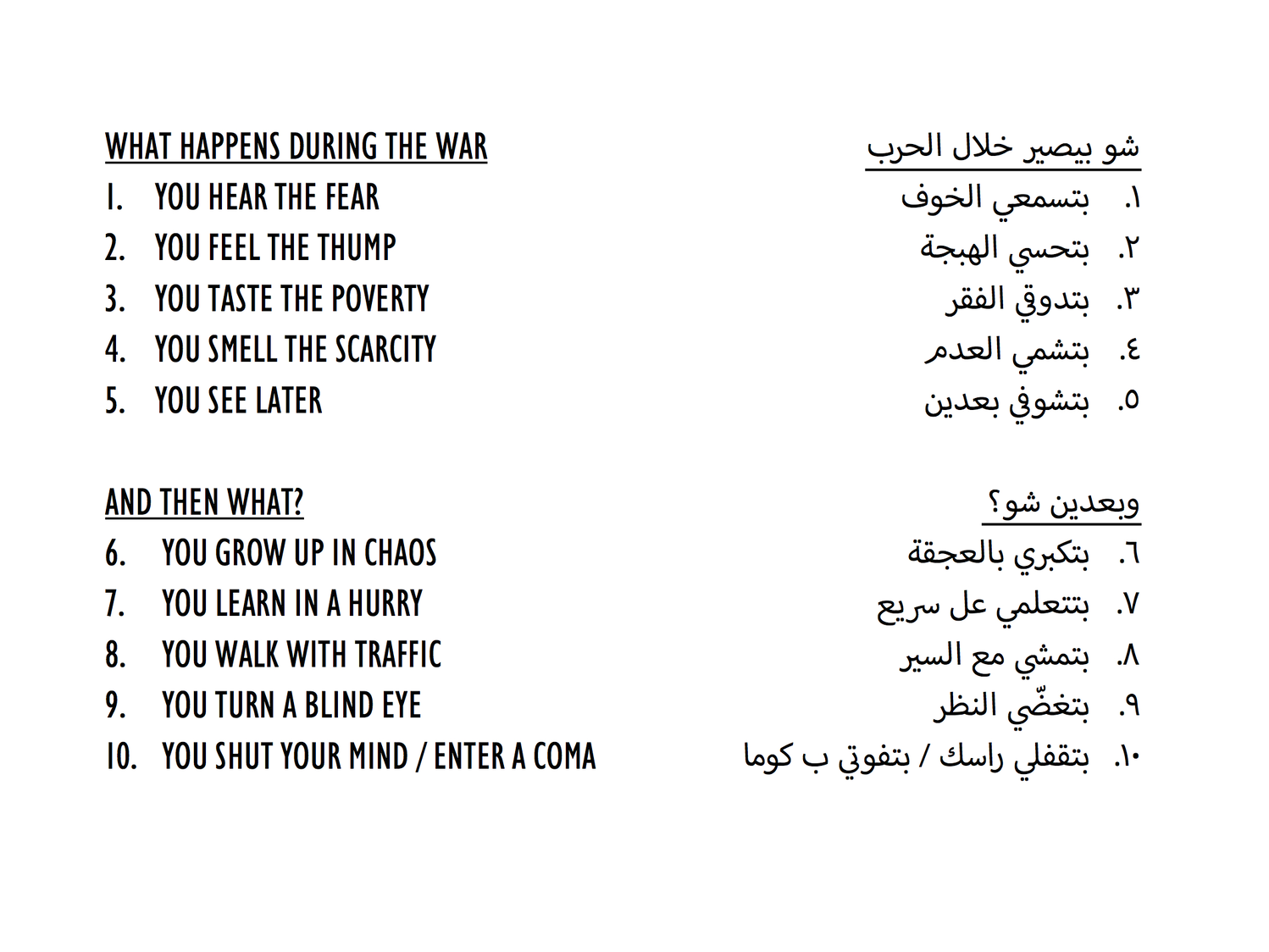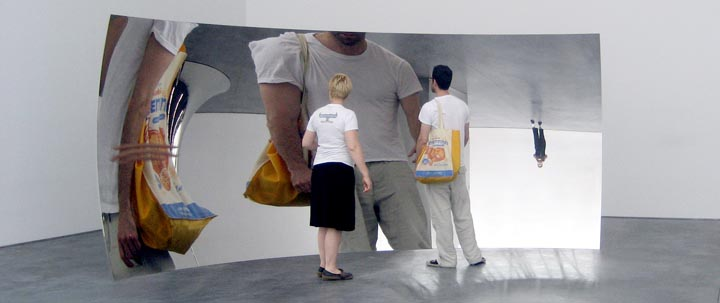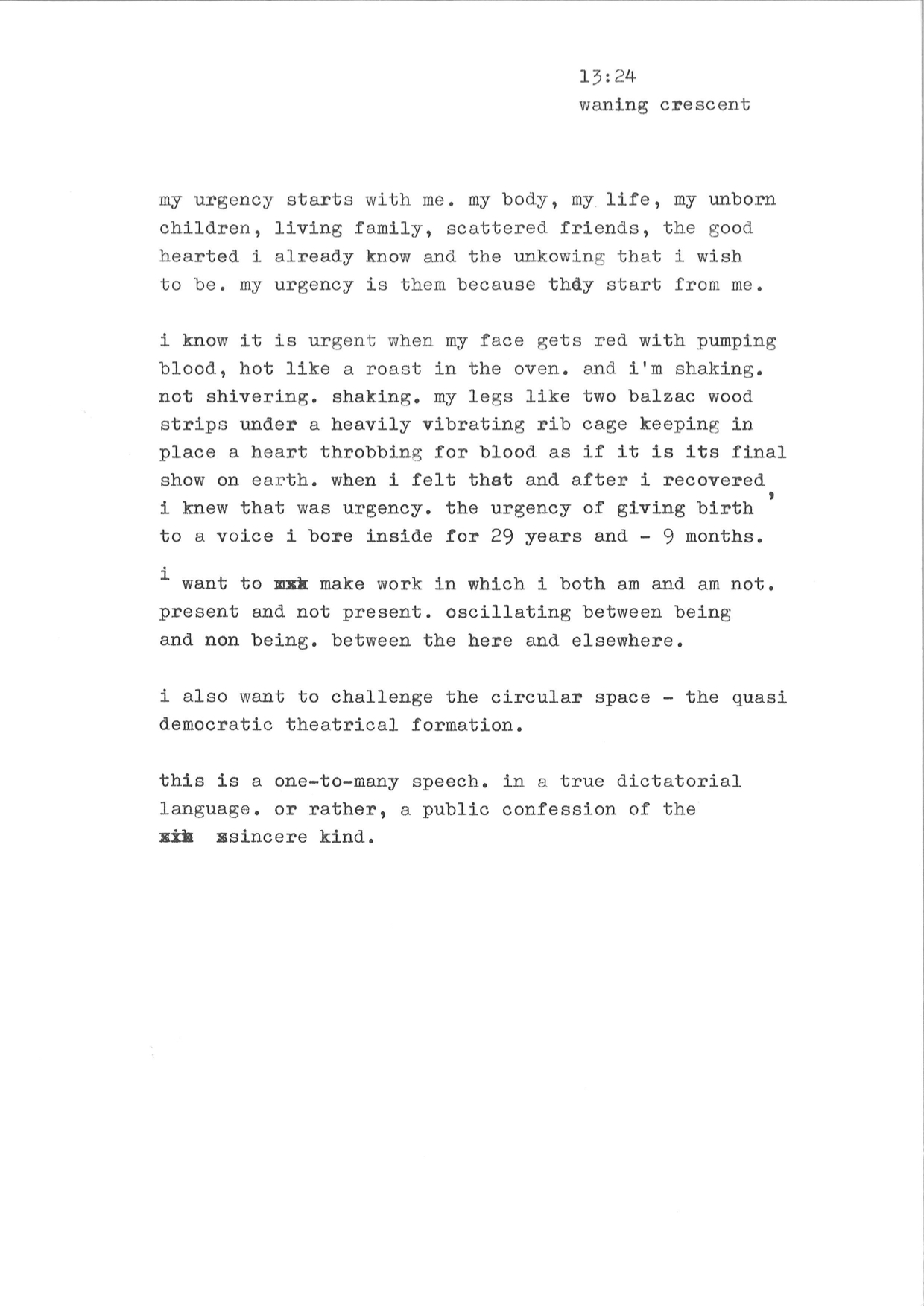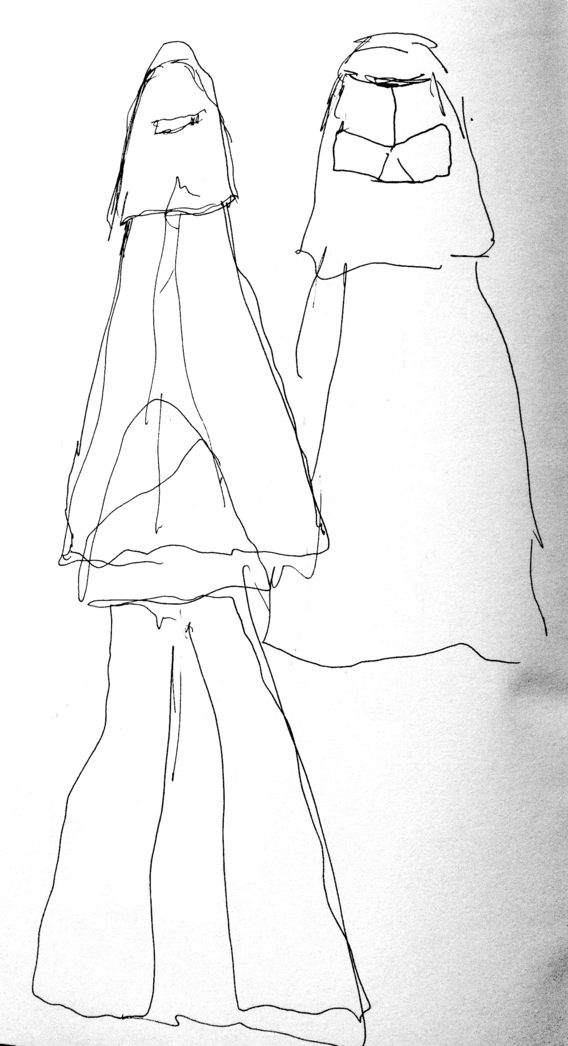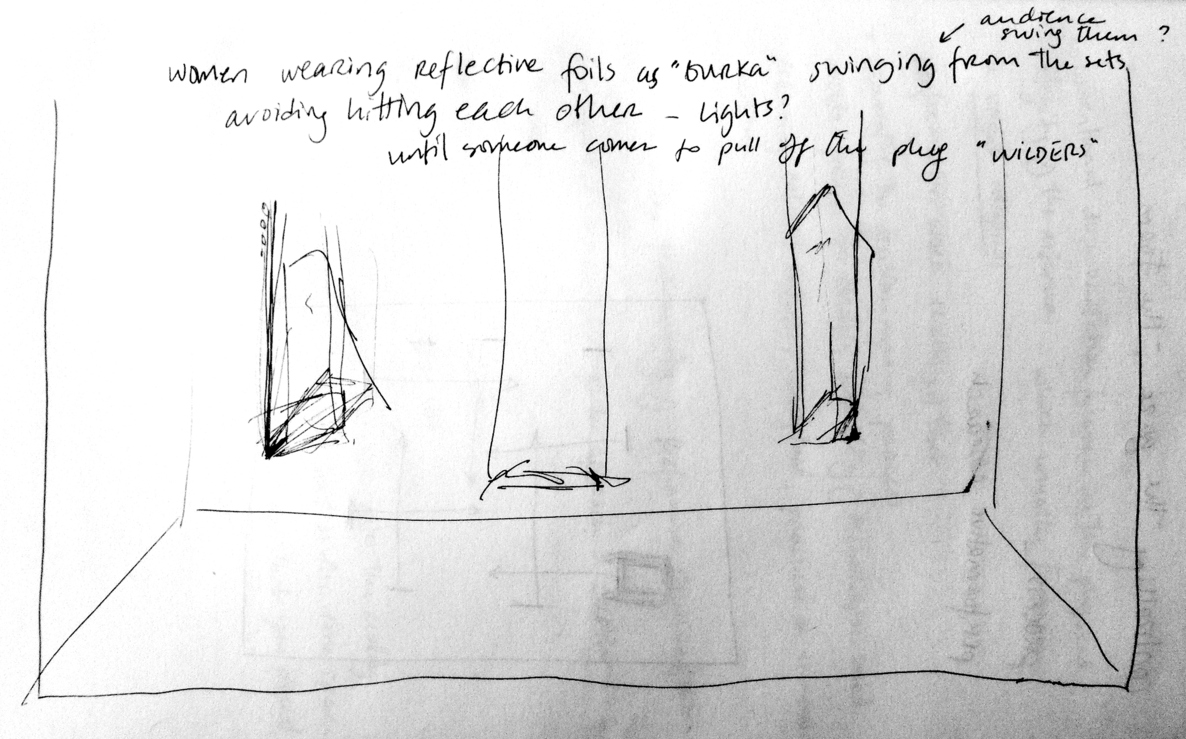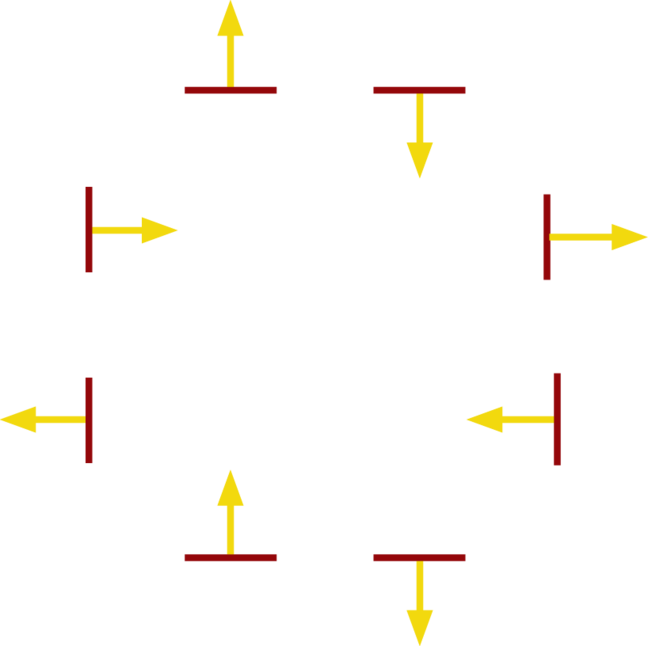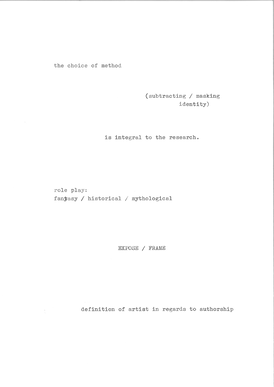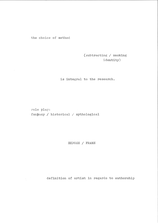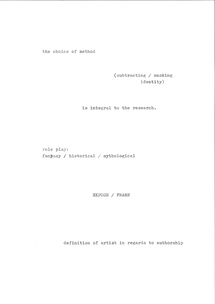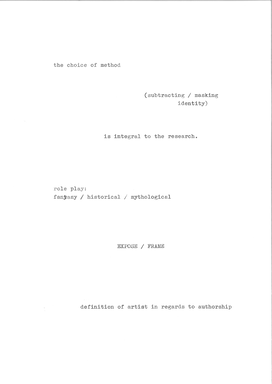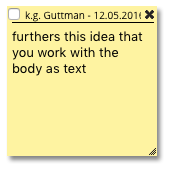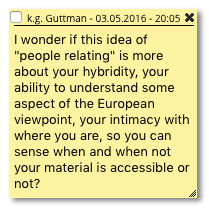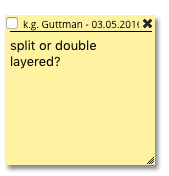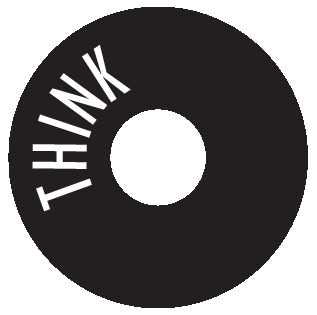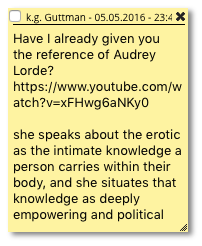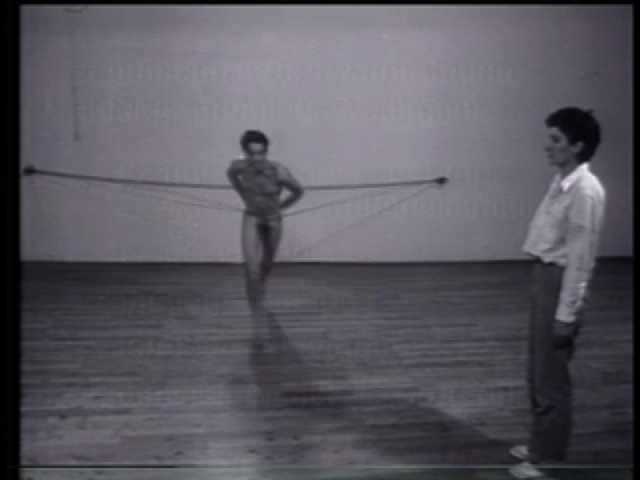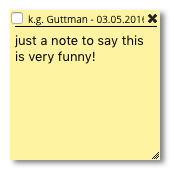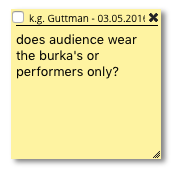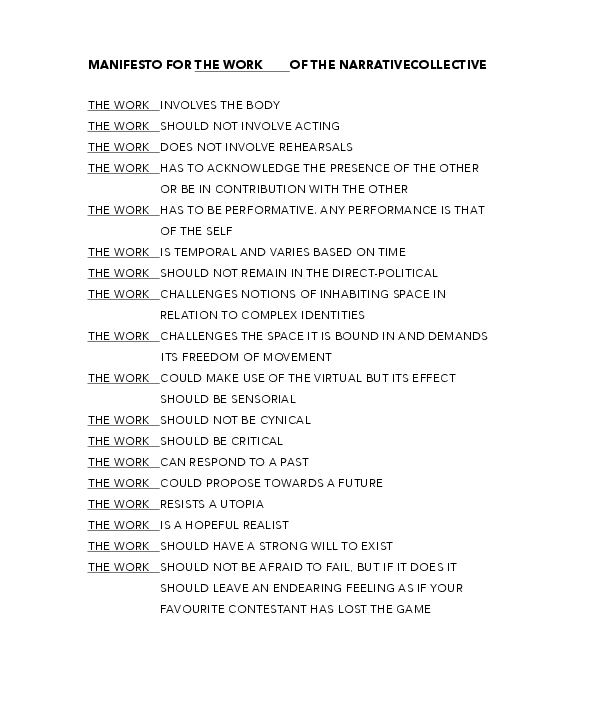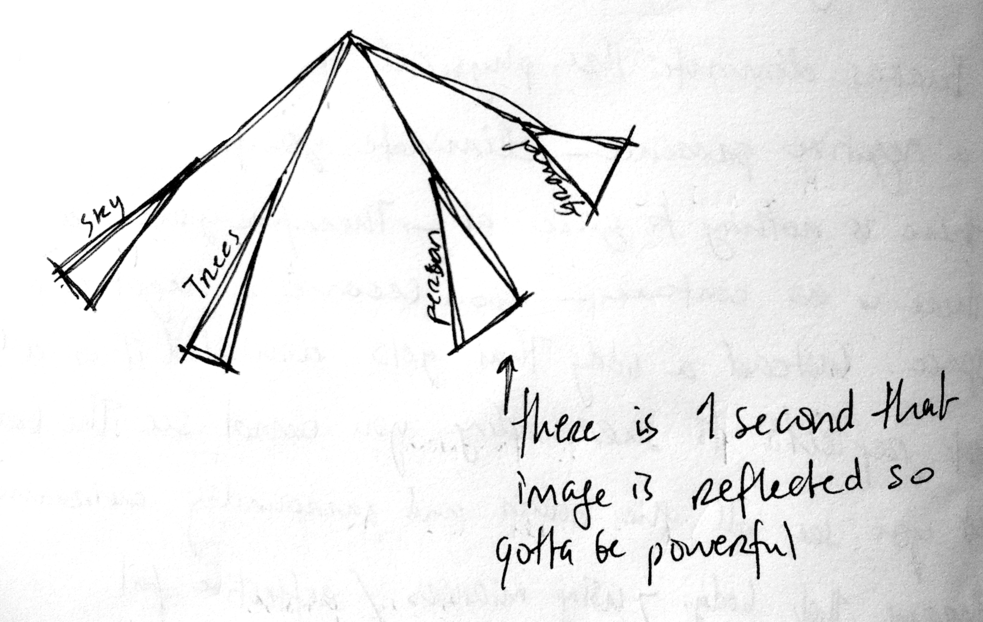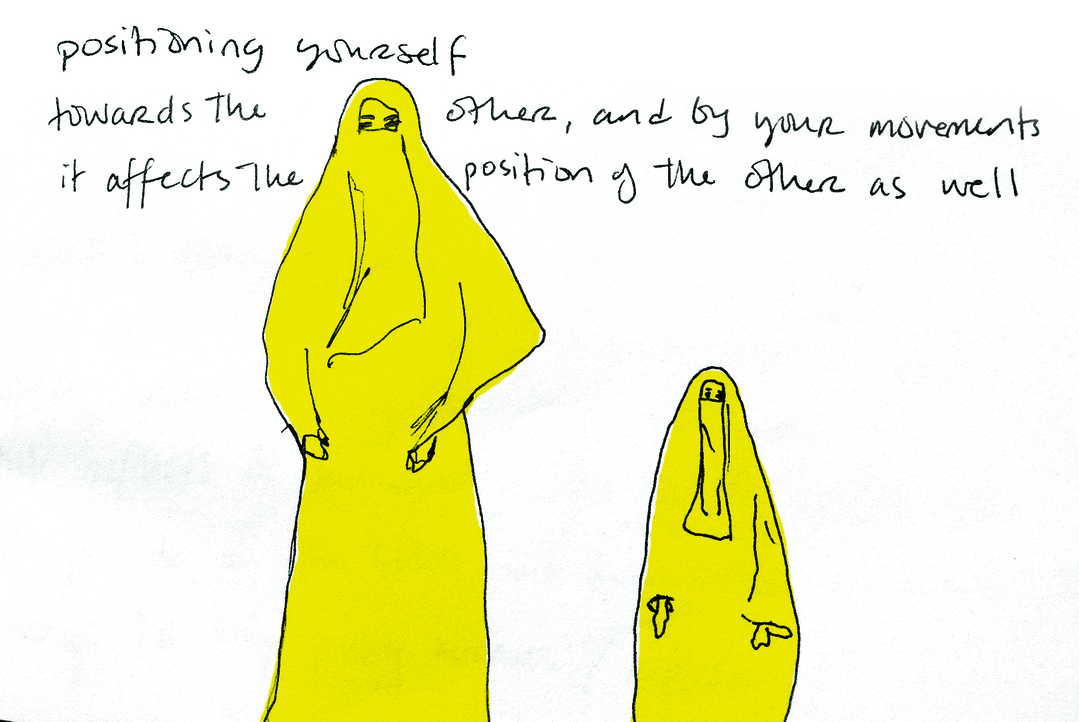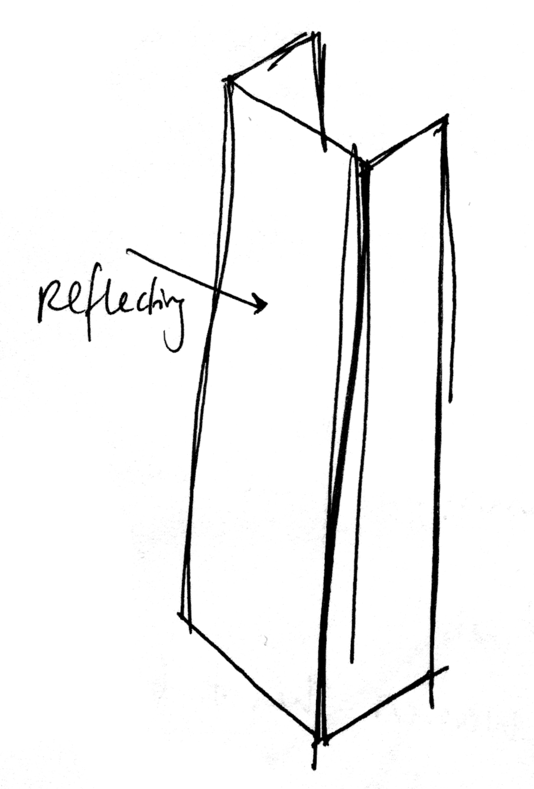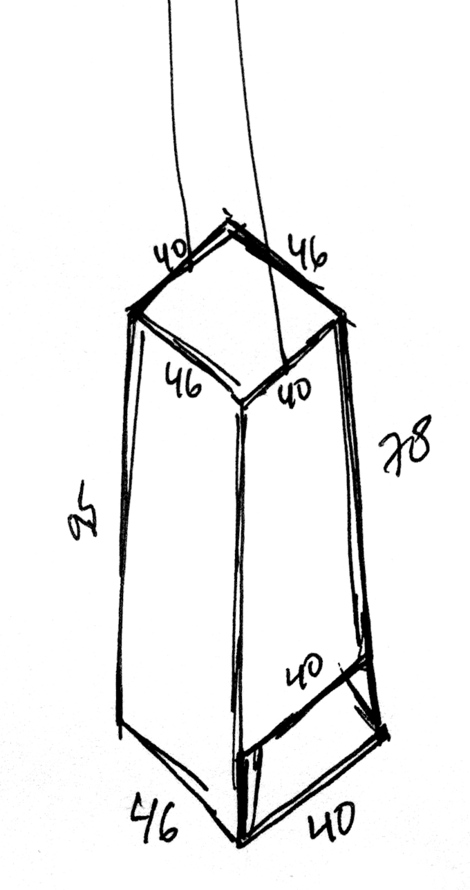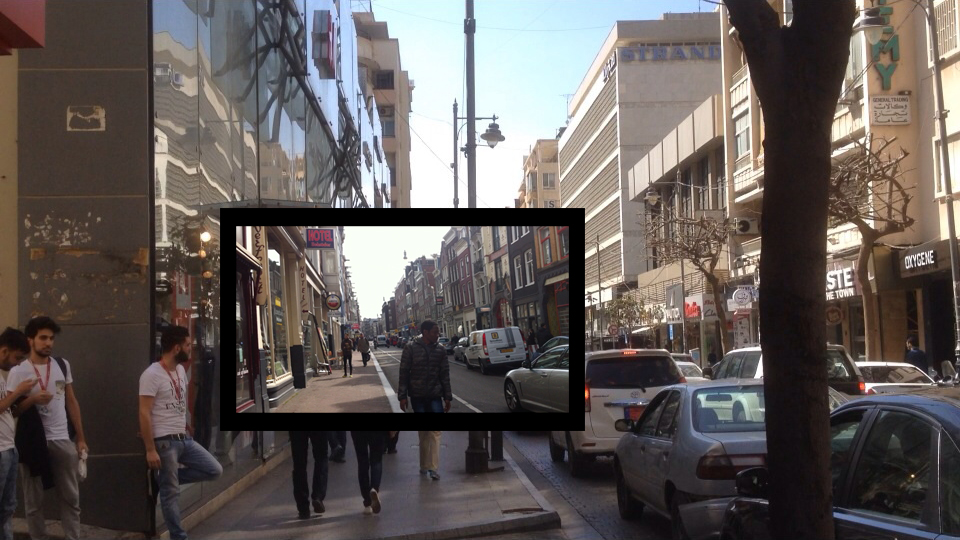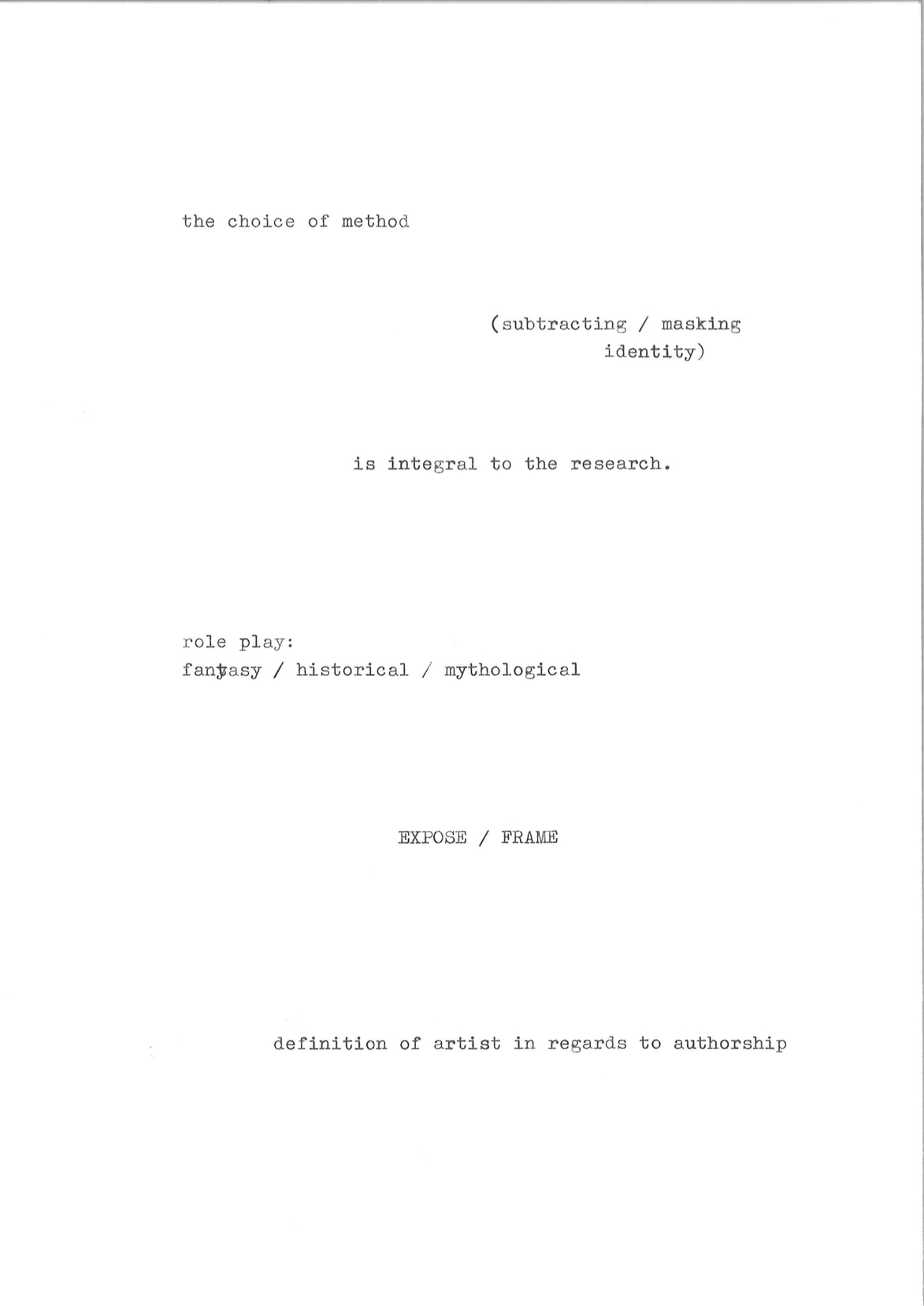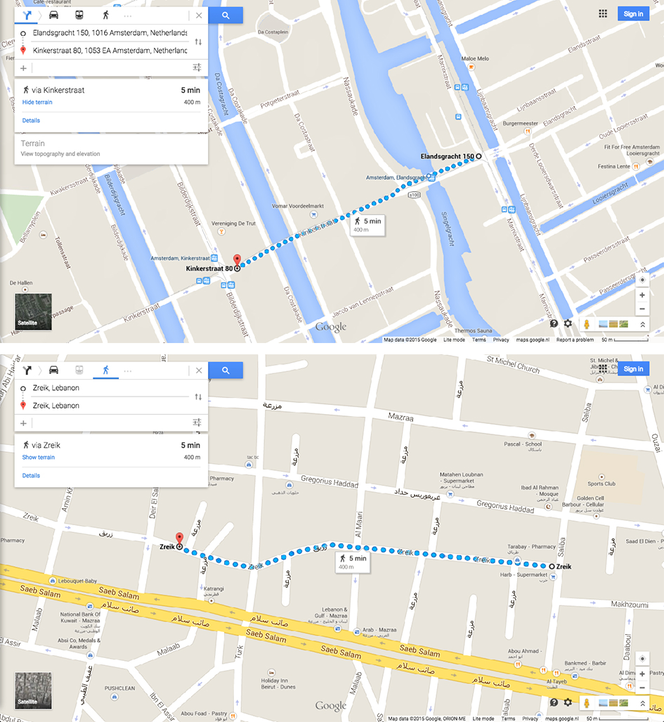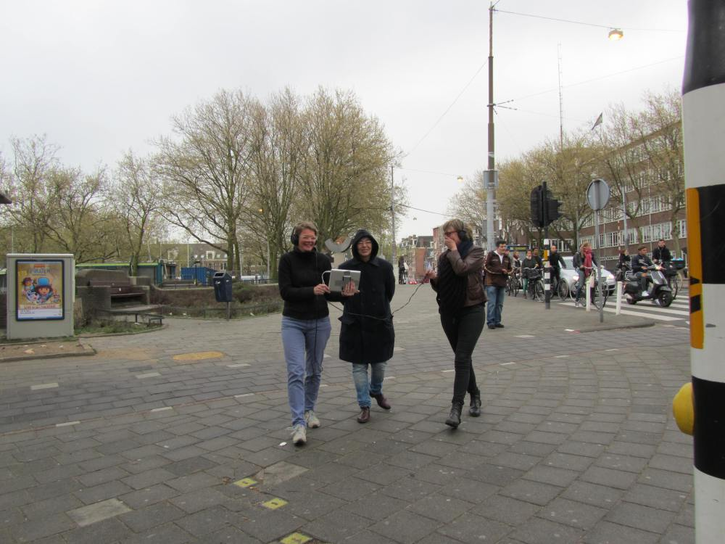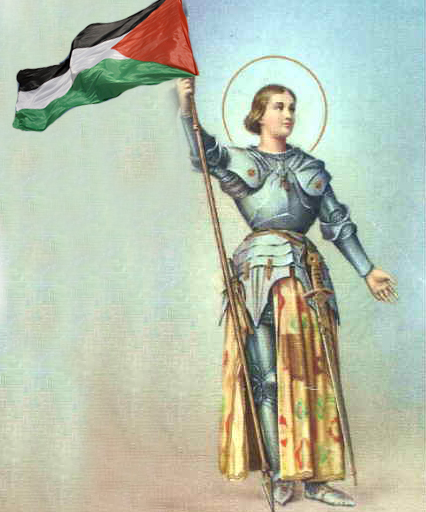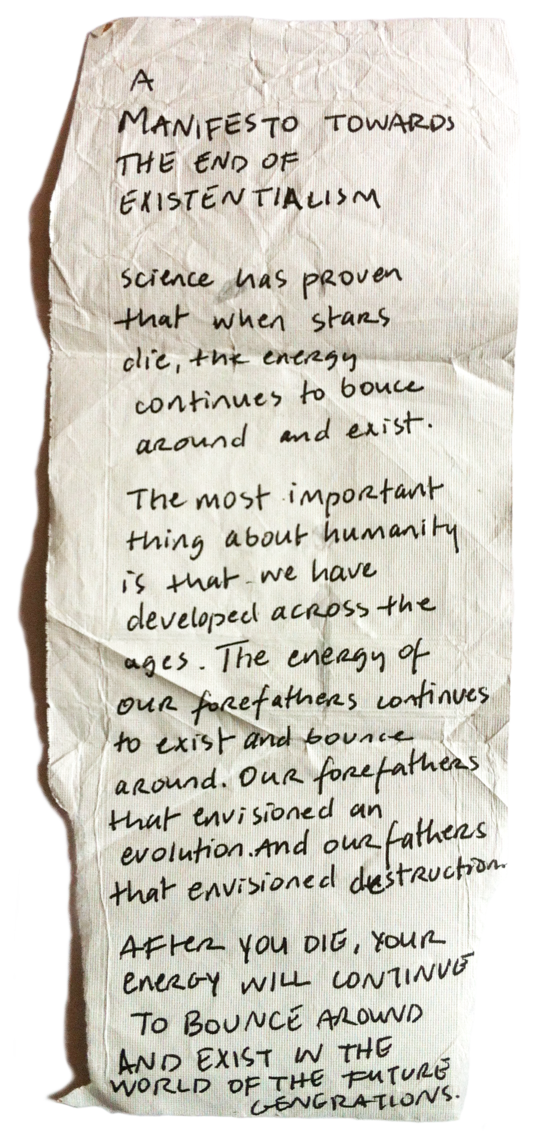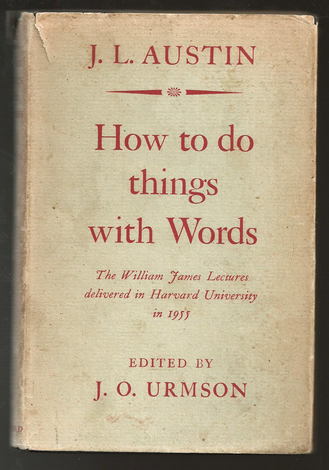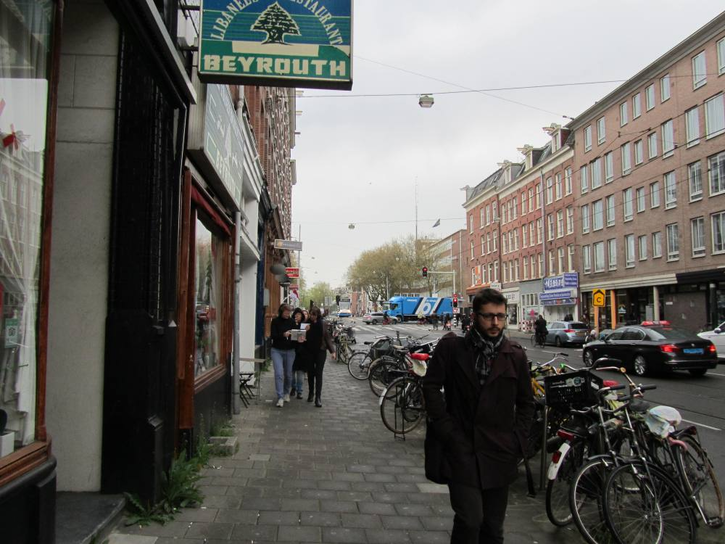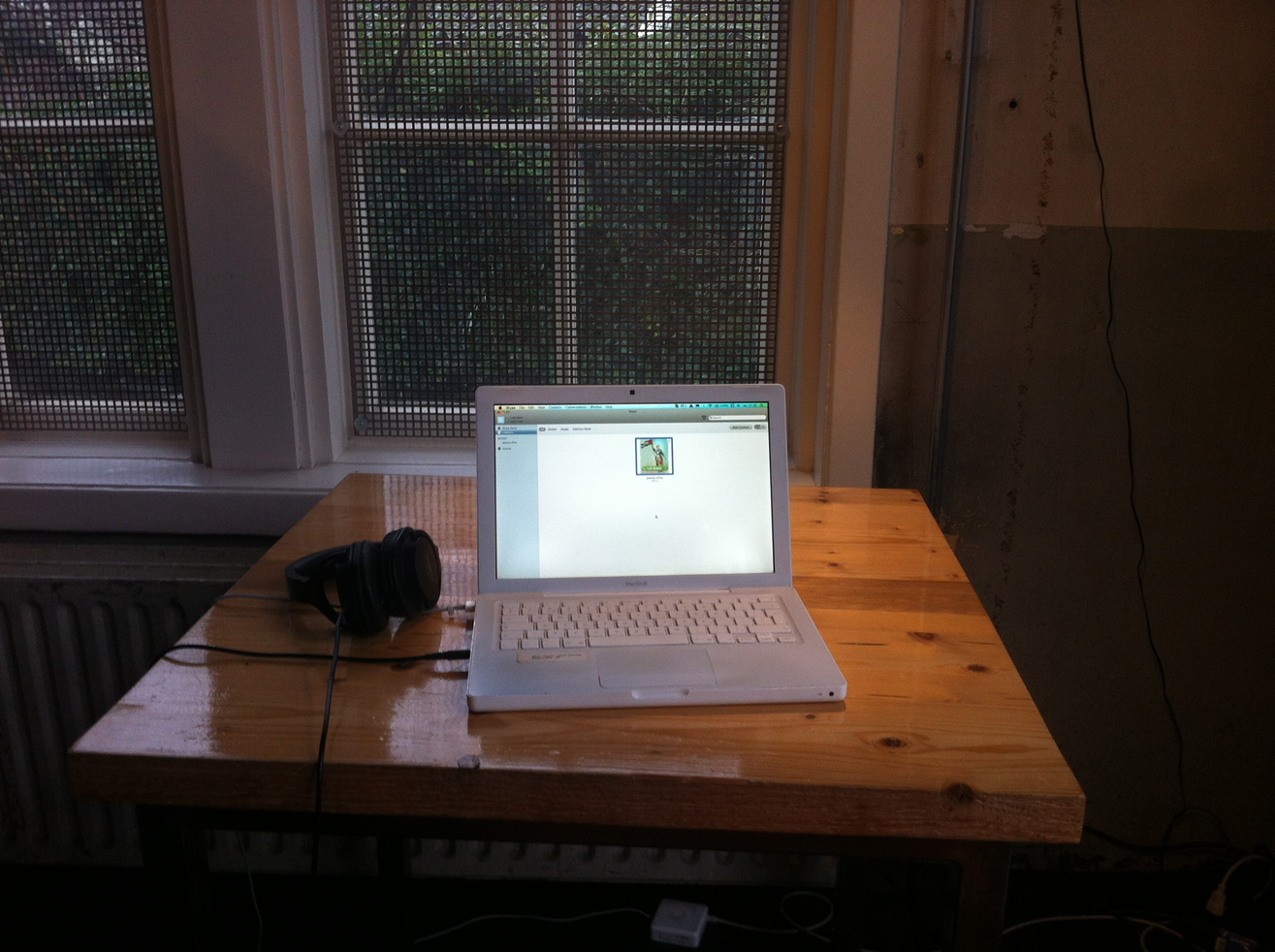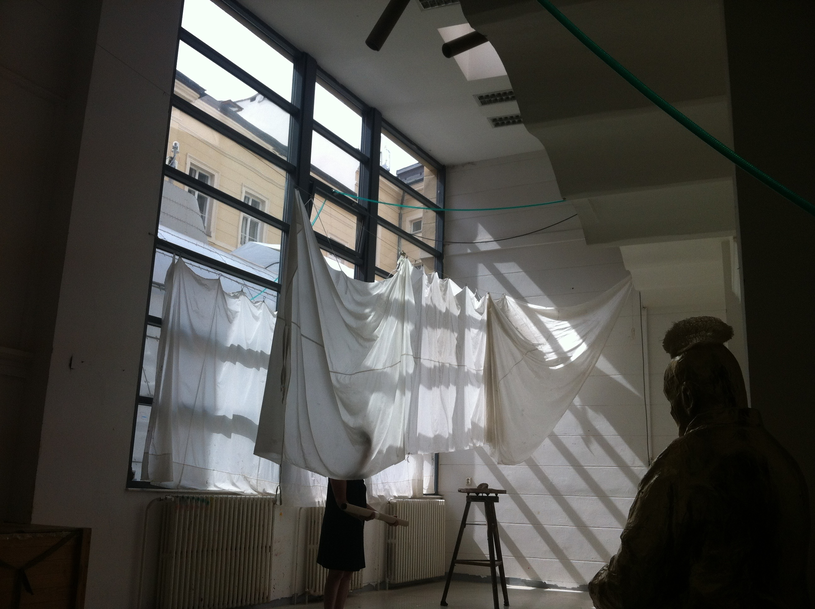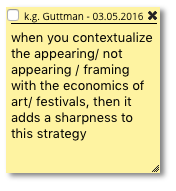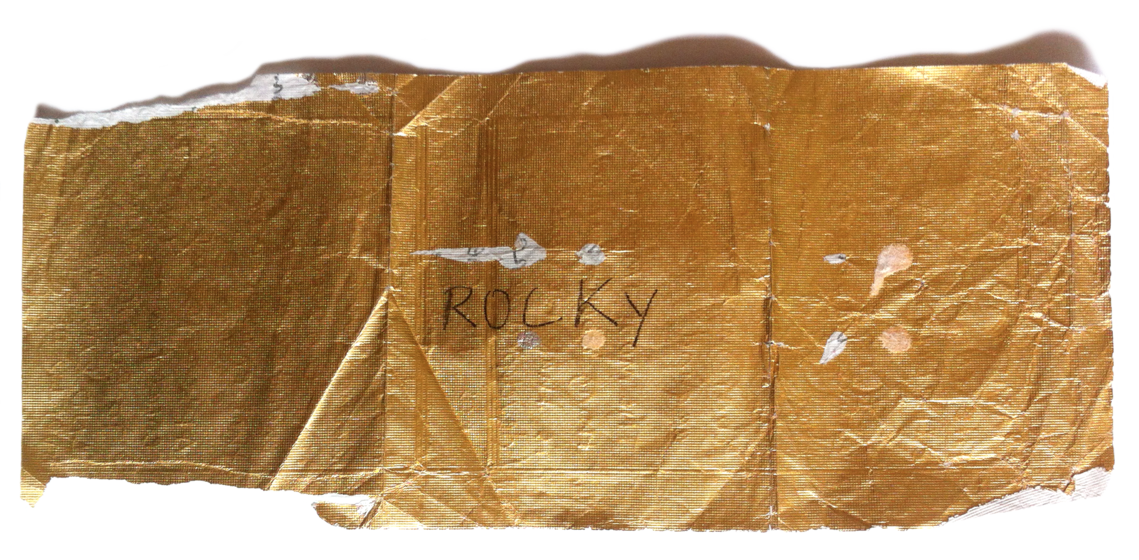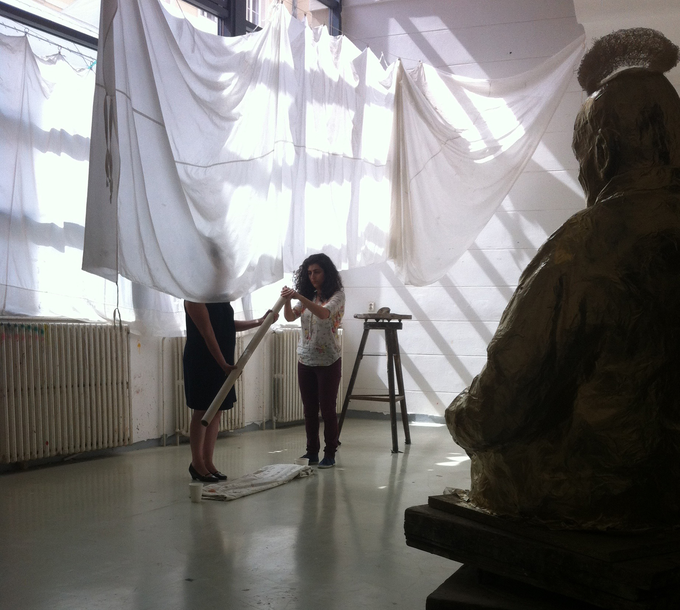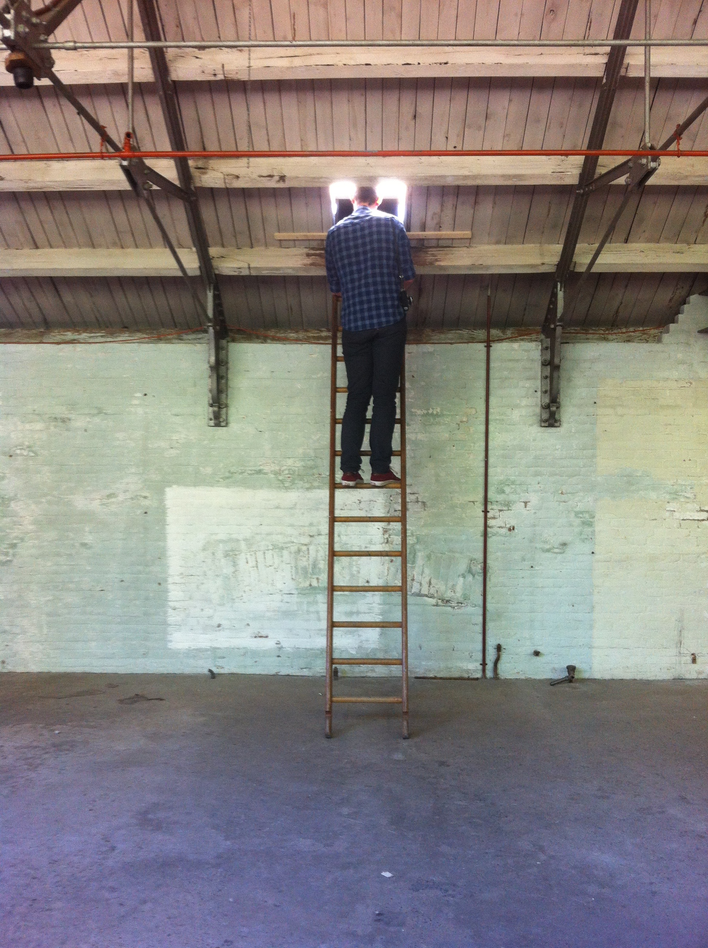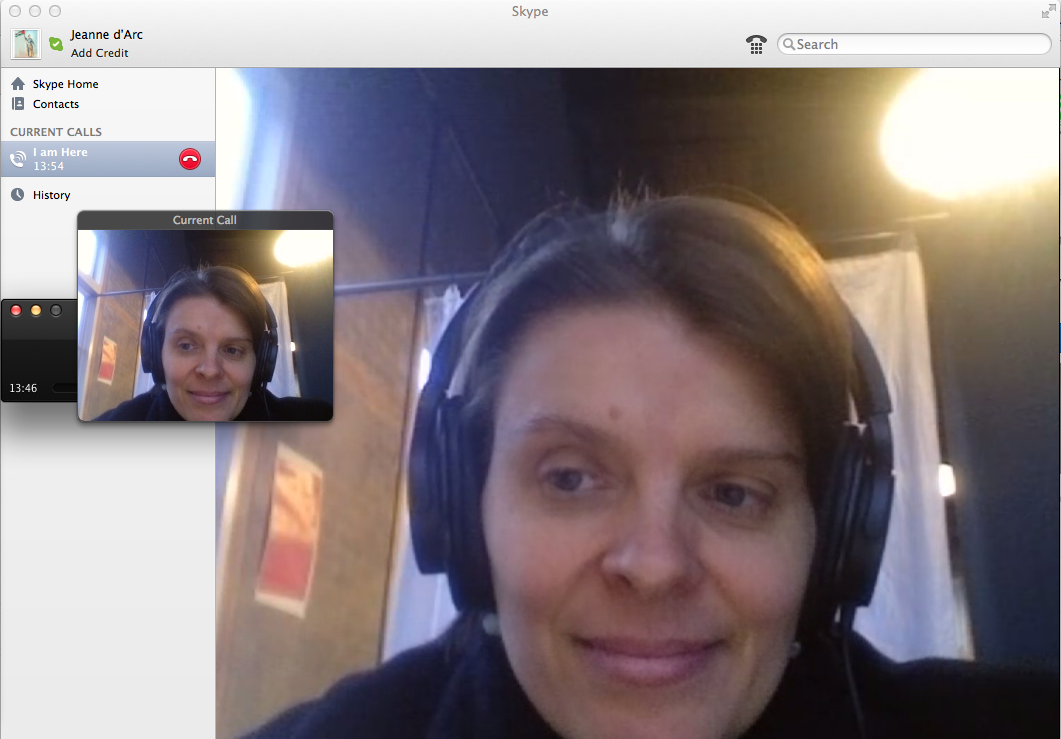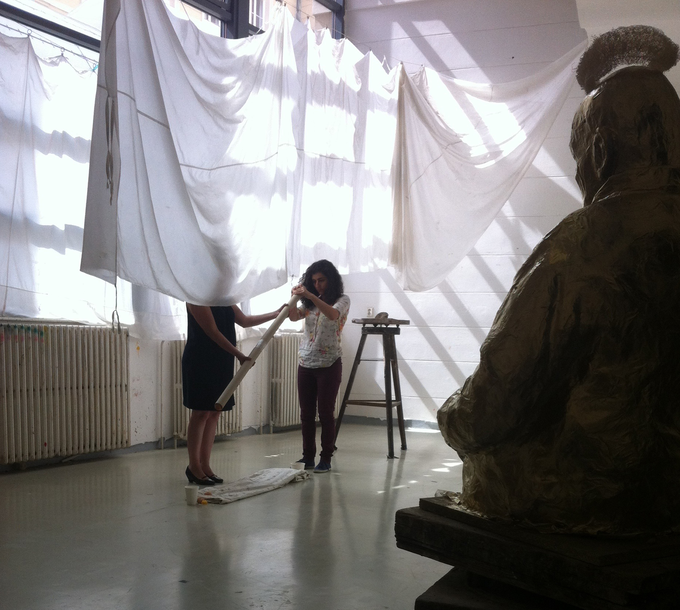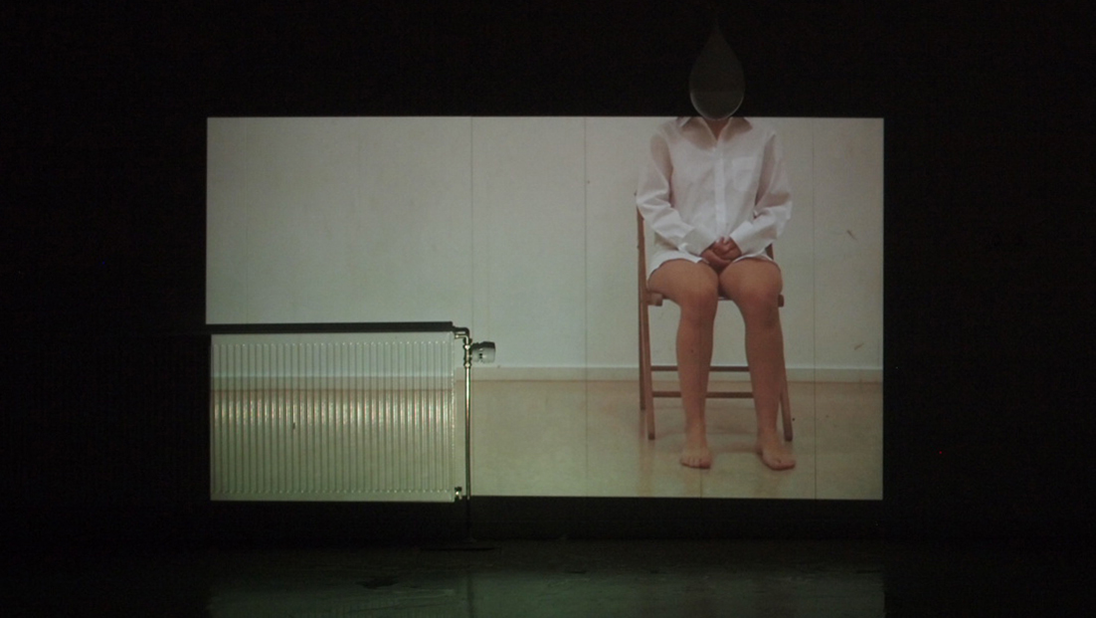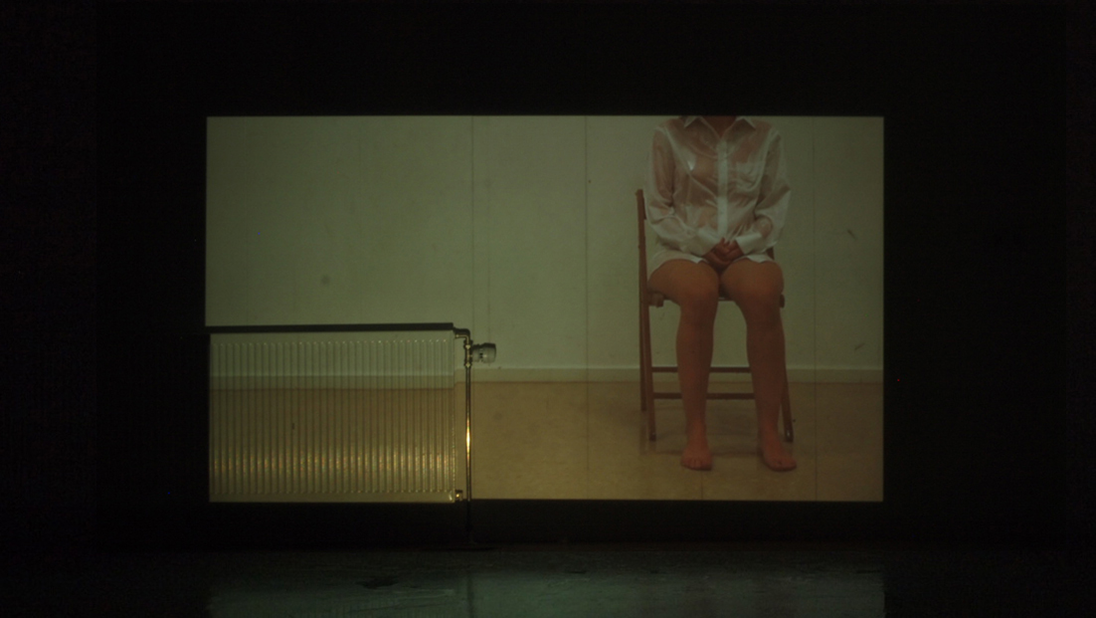October 2015 – I am preparing for a presentation about the research and the practical work that I did over the last year – what I have been doing, how it has taken form and the why behind it all.
I am writing out all the arguments and reasons, the -isms, philosophies and the grand narratives alongside visuals and a piled amount of work and bibliographies.
File saved. Go to bed.
__ “What is it that you want to show?”
__ What is it that I want to show?
When I speak whose voice comes out?
How many voices do I have?
Which voice touches you?
Lying restless in bed, I devised a coup – is that how revolutions get planned?
It is morning next and I am on the train re-writing the presentation in the voice of “I” - personalising the -isms, chewing over the philosophies I recited and internalising them into action, which pointed me in the direction of a subjective singularity instead of the grand narratives.
Close encounters of the third kind took form as my first non-verbal performative presentation.
There is a story to be told about two men who were born 100 years apart from each other. They could have been the same man, one who was born in France who later reincarnated in Lebanon. It is this man on the left – who quit school at age 11 in order to fill in his father's shoes as a family provider after becoming ill with asthma. He did whatever he could to be useful for himself and others. Road transport for clay pots, metalsmith, glass works, trade in ceramic tiles and sanitary furniture, shop owner then construction contractor, but essentially a poet and a restless soul – and exactly that essence is where Rimbaud from France meets Mohab in Lebanon, my father. My mother to his left is a story to be told at another time.
This artistic research opens discussions about subjectivities of performing the self through decontextualisation and recontextualisation of identities in subjective histories and contemporary narratives. The story of this man is my constant inspiration and motivation.
On this platform, the Research Catalogue, you the reader and me the initiator are meeting now for a chance to collaborate together. Our collaboration is towards creating together a performative research, where you can bring in your questions and observations to the content laid out here.
To become a collaborator you need to have a full account on Research Catalogue. If you already do or just have made one, then please click the button below and send a collaboration request to 'the narrativecollective'. As soon as you become a collaborator you will be able to post notes directly on this exposition. Whether collaborator or silent reader, please feel welcome to weave your own trajectory through this exposition.
This exposition maps out the artistic process, practice and research that I - under the operating name of The NarrativeCollective - have undergone over the last two years as part of the MA Scenography programme at the School of Arts in Utrecht, The Netherlands (HKU).
My process is material which I do not know where they lead to. But it is exactly this process of labour and courage of not knowing what this material will be for, which motivates and inspires me into further work and discovery. Throughout my process, I take deliberate time to document my thoughts and feelings about the work – reflection-in-action and reflection-on-action. These reflections take up their own forms as needed.
This exposition and the non-verbal performative presentations that I make (represented here) are an attempt to present the maker as researcher. This practice-led research method sits at the core of my work, where knowledge is brought up from the actions, histories and memories of the body. In this case, artistic research becomes a tool of remembering inherent knowledge.
Through this exposition, I am opening up my performative research process, and asking you as a reader to be a collaborator, or an artistic audit, by commenting directly on the content. Hovering over the blank squares reveals my own questions and comments on the process. I have lined out an optimal trajectory, but also feel free to wander off and create your own path, maybe that reveals new information or forms new connections that I hadn't thought of.
A Manifesto for
Performative Research
(2006)
– Brad Haseman –
"[...] these strategies re-interpret what is meant by ‘an original contribution to knowledge’. Rather than contribute to the intellectual or conceptual architecture of a discipline, these research enterprises are concerned with the improvement of practice, and new epistemologies of practice distilled from the insider’s understandings of action in context."
THE PERFORMANCE GETS MORE INTERESTING IF THE AUDIENCE KNOWS THAT IT IS A PERSONAL STORY. GIVE AN INTRODUCTION TO PREPARE THE AUDIENCE SO THEY SEE IT FROM THE RIGHT PERSPECTIVE. TO GIVE THEM THE SETTING AND THE CONTEXT
The idea of this project started from an intuitive image of eight women wearing reflective burkas and swinging in a choreographic composition on a public square. The women are in a two-axis grid, and they swing in such a choreography that they cross paths but just barely avoid a crash.
If on a public square, then the performance would happen around sunset with light on the edge of swings. If the audience is pushing the swings and see their image reflecting in the burkas, then their images go further away and then closer back to them as the women swing.
REPOSITIONING THE GAZE
Burkas eliminate the physical and transform the body into a negative presence, thus eliminating the body from the gaze. There is nothing to gaze at, it’s a visual vacuum. Therefore the body becomes absent - a negative in the space.
There is no contour. By covering the burka with a reflective material, instead of the body being eliminated, it becomes a body that reflects its surroundings. You cannot see the body but you see all the bodies and surrounding environment through that body (through using mirrors or reflective foil). This performance can be mapped out along a trajectory. Maybe 8 women on one spot is too much that it becomes a spectacle. Therefore to create a trajectory throughout the city where you could see these women sparsely to dilute this spectacularity – swinging from trees, walking on the sidewalk and rowing in the canals.
Your body is a reflection of the surrounding
Create a screen or a skin which can be appropriated to the body. You are in a moment of disbelief and not thinking if it is the shape of the body or an object. Because you are looking at the image. That’s what is important.
I have to focus on what the people see and not just on what I want.
Maybe play on the idea of tension and spectacle - THIS moment of possible confrontation:
There is only 1 second and it crashes
There is only 1 second and you see yourself
There is only 1 second and you see the other
MAKE A MANIFESTO AS A GUIDE TO MAKE DECISIONS
Non-verbal performative presentation:
Close Encounters of the Third Kind (2015)
She was lying behind a red table turned to its side. The red table is in itself an unworkable working station, which is 5 metres long and 35 centimetres wide with unequal leg heights so that it stands at a slant. Turned to its side, at only 35cm height, her body becomes hidden from view of the audience. In this setup the performative presentation takes place.
As the projected slides roll forwards, the performer takes off and throws clothes towards the viewers: sweater, trousers, shirt, socks and underwear at various rhythm. Then she starts throwing mandarines. At first one, then another, then two at a time, then one again, at various rhythms. This goes on while the projected slides are rolling forward.
After the last slide, she gets up, now a naked body, and dresses into prepared clothes on a pillar; a white robe and a black abaya. Then she goes back lying behind the red table.
The urgency and the work with the body are not disconnected from the political. It is about knowing where the work lies and articulating that seamlessness through the categories that I set up for myself - the happening and the becoming - and grounding them in sensorial bodily experience within the performance. Then through the audience I can track both parallels of the interaction in my own voice and my own passage, as I happen and I become.
HOW DO I TELL ALL THESE STORIES WITHOUT BEING SUPER NARRATIVE?
FOR ME THERE IS NOTHING AGAINST THE SUPER NARRATIVE. IF IT IS A GOOD NARRATIVE, I AM VERY PLEASED TO HEAR IT OR READ IT BEFORE THE PERFORMANCE. THERE ARE MANY WAYS TO GIVE THE AUDIENCE THE SETTING/CONTEXT. THEATRE IS QUITE A GOOD MEDIUM FOR IT. TO USE THE LANGUAGE. IN THE TRADITION OF THEATRE IT IS QUITE COMMON TO TELL A STORY TO YOUR AUDIENCE. THE LANGUAGE IS THE WHOLE DISCIPLINE OF THE THEATRE. ART SCHOOLS ADVOCATE TO BE COMPLICATED AND VAGUE IN LANGUAGE. BUT THEATRE GIVES THE SPACE FOR STORYTELLING AND THERE IS NOTHING WRONG ABOUT TELLING STORIES. DON’T PUT THE STORY IN A STRANGE BOX SO THAT NO ONE CAN HEAR IT.
BUT THEN HOW CAN I PRESENT THESE STORIES WITHOUT BEING SO DRAMATIC. THESE TOPICS ARE ALREADY VERY LOADED AND IT IS PAINFUL. IT IS PAINFUL FOR ME. IT IS SHIT WHAT I HAD TO GO THROUGH BUT I DON’T WANT PEOPLE TO FEEL SORRY FOR ME.
THERE ARE SO MANY OF THESE STORIES BUT THERE IS A DIFFERENCE WHEN SOMEONE IN FRONT OF YOU TELLS IT. THE WAY TO TELL EMOTIONAL STORIES IN DETAILED CONCRETE DESCRIPTION.
I DON’T HAVE TO TELL THE ADJECTIVES THAT IT WAS SHIT AND CLAUSTROPHOBIC BECAUSE THAT’S FOR THE AUDIENCE TO FILL IN. I CAN JUST OFFER THE CONCRETE DETAILS. I TELL MYSELF THESE STORIES BECAUSE REALLY OTHERWISE I WOULD DIE. I JUST TELL THEM VERBALLY WITHOUT WRITING THEM DOWN BECAUSE I DON’T KNOW WHAT LANGUAGE TO WRITE THEM IN. I LIKE TO TELL THEM AND MAYBE SOMETHING CHANGES EVERY TIME I TELL THEM. HOWEVER WHEN YOU’RE YOUNG YOU THINK YOU WILL BE YOUNG FOREVER AND REMEMBER THINGS AS YOU REMEMBER THEM NOW. THAT’S DELUSIONAL.
IT IS DIFFICULT TO USE MYRSELF IN WORK. BECAUSE I AM ALSO INTERESTED IN THE CONTEXT, IN OTHER PEOPLE, IN THE SOCIETAL SITUATIONS AND I DON’T WANT TO LOSE THAT.
TELL A PERSONAL STORY TO TELL ABOUT A GREATER THING, WHICH IS MORE INTERESTING. THE PERSONAL FIELD IS A VERY INTENSE ENTRANCE INTO YOUR STORY. BECAUSE PEOPLE CAN RELATE TO THAT. YOU HAVE TO MAKE SURE THAT PEOPLE CAN STILL RELATE TO IT.
SO THAT IT DOESN’T REMAIN ONLY MY STORY.
THE PERSONAL STORIES EMPHASISES THE INDIVIDUAL AND THE HUMAN SCALE AND NOT JUST QUANTITIES OF COMMUNITIES AND NATIONALITIES.
I HAVE A FEELING THAT I AM SPLIT IN MY BRAIN. I HAVE THE CONDITIONING FROM THE PLACE WHERE I WAS BROUGHT UP – BODY ETHICS SUCH AS NOT SHOWING YOURSELF NAKED, NOT LETTING A BOY TOUCH YOUR HAIR IF YOU’RE NOT MARRIED, THESE KIND OF CODES THAT MY PARENTS PUT IN ME. AND ON THE OTHER SIDE THERE IS THE EMANCIPATED WOMEN IN ME THAT JUDGES THESE THINGS AND CONFIRMS THAT I AM MY OWN INDEPENDENT PERSON AND I HAVE TO BE STRONG AND NOT LIVE UNDER THAT UMBRELLA, BOTH TWO ARE REALLY EQUAL. I JUDGE MYSELF AND I FIGHT IT CONSTANTLY.
in conversation with MICHIEL VOET
mentor for artistic practice
Side thoughts on participatory forms of art
Could it be that an audience would feel subjugated and uncomfortable in democratic situations which are demanding active participation, as in social practice as in theatrical set-ups? This, however, varies based on how well-informed the subject is of the situation and the degree their opinion affects their own situation. One is more reluctant and uncomfortable to vote on an ill-informed referendum of distant effect on one's daily life in comparison to voting on municipal elections. Similarly in theatrical situations, participation of audience needs to be clearly communicated and employed as a vital contribution or rather collaboration that affects the course of the performance, rather than an enactment of pre-determined sequences set-out by the maker(s). Not to say that the latter is an invalid method, but just does not qualify for the notions of participatory art.
In my work, I try to play with a tension of seeing but not making an action, leading the spectator to possible self-awareness of incapability. Depending on how to involve the spectator, ridding them from the possibility to interact, I like to enforce through physicality our community’s paralysis. Upon such a political backdrop, even this factor of information control can be appropriated.
The notion of role-reversal where the spectator becomes a performer might as well be perceived as an idealistic misnomer. When a performance is sans performer, and the action only happens as the spectator enters the space, is that enough to make the spectator the performer? Isn’t the space in this case the performer, and the spectator being the activator or the reacted-upon? In the creation process of a performance, the maker defines the route and the interactive tools possible for the visitors to interact with. At the time when the visitors enter this space, they are indeed more than just spectators looking upon what is presented, and would be reacting and interacting with the set tools along the mapped out route. So are they then transformed into performers in this space, or are they not meta-performers referring to the original performer completing or adding on to the original creation and involving themselves within the constructed work?
In terms of scenography, my ideas start from the spatial and/or temporal organisation of the viewers, their position towards the work and visuality - how to position them towards the intended point(s) of attention. My notions of space are informed by the spectator. My thoughts on spatial organisation start from where the spectators enter the theatrical space, how are they organised towards the happening, and what is implied from their formation / distribution and situation of which they enter from and enter into. I try to play with theatrical authority and quasi-democracy. But I am also interested to lose this artistic authority and trade in audience with public. Audience – being spectators with the potentiality to transform or to have a moment of emancipation, at least as a utopian wish. And public – being of the wandering commons, unexpecting, causing ruptures in their daily routines. In terms of space itself, I am sensitive towards dimensions and the sculptural aspect of my own work – the position of people towards it, and the relation of the work to the space it exists in.
Gender Trouble
(1990)
– Judith Butler –
Construction of identity
is caused by performative actions, as it follows
from the theory of
performativity.
Because of the action
you get your
identity.
The process is still continuing, when do I stop writing when the process is ongoing?
There will be updates about this project on the website: www.thenarrativecollective.com
REACT - POSITION - GO INTO YOURSELF
WHEN YOU MOVE, YOUR HISTORY COMES UP
IDENTITY NOT FOCUSED ON UNIQUENESS
To make swings where you just barely cannot touch each other as a comment on how we work and communicate on an individual and societal level
MAYBE THIS IDEA CAN BE SPLIT INTO TWO INSTALLATIONS:
1. SWINGING MOVEMENT
2. REFLECTING IN THE BODY OF THE OTHER
Testing if the “reflecting burka” is in an enclosed space instead of a public open space.
I can think of trajectories in public space – an audio walk tour / virtual walk / guided or unguided walk according to a given map.
I can think of women walking / swinging – or images of these women floating / superimposed on building facades, escaping frames.
I can think of a monumental construction that you walk into alone for an intimate and condensed experience.
I can imagine this idea to surpass the actual burka and extend towards the other
PERFORMANCE OF THE SELF + POLYVOCALITY
The audience is around the swing, either standing or sitting. There is a mirror divider between the two spaces. And there are walls around the space. The audience has a space that they can walk through from one space to another. The swing moves from one space to another. I swing between the two halves - the land of origin and the land of migration. The images are reflected on the mirror division in the middle of the space. As a spectator you only see one half at a time.
I am 50% of the time hidden – hidden in time, not in space.
The feet are sticking out from the swing. But if my legs are dangling from the swing then the symmetry of the space is lost. It would seem as if I have a preferred space and always swinging towards that space. What if I use another set of fake legs, or a mermaid tail? Or the swing turns around its own axis instead of swinging back and forth. Maybe I am not on a swing and instead of the swing there is a revolving door in the middle of the space. But then the immersion in and entrance deep into the space is gone. This makes me think of Ulay/Abramović's performance 'Incision (1978)' with the elastic rope.
No, that is something else. The idea of using the swing is to highlight this continuous mechanical movement set by the body’s momentum. Once the swing is in motion; its velocity is determined by the body's initial push, it starts decreasing in speed due to physical factors such as friction, body mass and gravity. This movement diminishes into stillness, or is consciously stopped by the person on the swing by pinning their feet into the ground, bring the swing to a stop.
All these mentioned factors, the mechanics, the gravity, the movement and body mass, the surrender or conscious control are vital factors and metaphors employed in this installation project.
Claire Bishop (2012) Artificial Hells: Participatory Art and the Politics of Spectatorship
– Leah Lovett –
"Bishop sees the role of the artist as bringing out social relations of tension which are otherwise repressed by maintaining aesthetic oppositions between actor/spectator, artist/ participant, art/life
and so on."
If they are all burka-dressed women, this could be seen as a homogenised image.
What if there are some performers on swings and some empty swings as an invitation for audience to join in
If this performance would happen in a public space, then I would use the existing trees to hang the sings from rather than install a scaffolding. However, the distance between the swings is very important.
Is it possible to separate this idea into two different but related installations.
Allow all the layers to exist.
Allow for complexity.
Politics and dichotomies of countries:
- Individuality versus community
- Separated and exerting effort to come together
- You don’t want to crash, or maybe you do
Personal versus global relationships
Meeting Cities: Beirut – Amsterdam (2015)
‘Meeting Cities’ is a crossover tour and a parallel city walk. A person in Amsterdam walks 400m direction West together with a person walking 400m direction West in Beirut, ending on their respective roofs. The parallel walk is arranged over Skype, on a tablet, with a camera at the back side. They exchange the view of their walk.
Lecture Performance: Superheroes Wear Masks (2015)
This lecture performance discussing the artistic voice and its authorship takes place within an installation comprised of a 5-metre long mirror hanging horizontally and a 5-metre long table standing at a slanted angle. I – am sitting behind the mirror – a body with all the heads of the audience sitting across.
Thinking the Doing
I feel a certain resistance towards the doing when things become too staged. It feels as if the urge of making is satisfied by verbalising the thoughts aided with sketches and scale models. Although making the work will undoubtedly reveal new information especially in terms of interacting with the audience, there is a point during the thinking process where I feel uneasy and become less curious. Is it a resistence towards an end product? Or holding back to prolong the exciting feeling of pondering and brainstorming?
When is a work 'made'?
One audience reaction:
"Can you explore a bit about "I" in regards to the issue of authorship and the self, and in what way you want to be present or visible as the author of work?"
Skype call with Jeanne d'Arc (2014)
A Skype conversation between Jeanne d'Arc - who is re-born in nowaday Palestine - and a participant on the contemporary notions of idealogy, heroism and terrorism through historical, fictional and medial distance.
Performing Histories: Jeanne d’Arc: The Rise of a Hero – The Fall of a Terrorist (2015)
A woman, her head hidden behind a white curtain, holding a tube parallel to the ground. Viewers are at the balcony, looking at this scene from their own tubes serving as a monocular. Chicken eggs – perfect and complete, a product of failed fertility – pass through a tube, fall into the cup at the other end. Some eggs fall into the cup, some outside, some roll forward unbroken, some smash and explode.
Eliminating the biography of the maker to not put any kind of further reading into the work in terms of identity is an attempt to separate the biography from the work to allow for wider interpretation and to disrupt systems of power.
One strategy could be simply not appearing, or sitting on the fringe of being and non-being, whether by removing the voice or hiding the body. Such a strategy of not appearing challenges certain economic and institutional ideas of attributing value based on quantifiable assets. A biography with factual information about place of birth and institutional certifications is an economical tool and the way of using it and exploiting it is used as a frame to bounce from towards a broader existence.
Cultural identities and their representation is a trace of colonising and homogenising powers which demand the performance of what is perceived of the culture and the tradition of the other. Acts of creative processes, however, speculate towards a future and disrupt these constructed identities and institutionalised performances of self towards uncontrolled and unorganised spaces of existence.
Therefore how to go into strategies of complexifying identity through speculation and multiplication? How to use the body and its objective history towards a complexity of appropriating multiple identities at once? And how to make a physical shift between the new world (post-colonial west asia) and a place deeply embedded in colonial history (west europe)?
How to Do Things With Words (1955/1962)
J.L. Austin
"In these examples [“I do”; “I name this ship the Queen Elizabeth”] it seems clear that to utter the sentence (in, of course, the appropriate circumstances) is not to describe my doing of what I should be said in so uttering to be doing or to state that I am doing it: it is to do it the issuing of the utterance is the performing of an action."
On using performance lectures as form
In this process of work, performance lectures are used as a form for reflection. Using this method has been productive to bring up insights and new knowledge which would spin into a new work. Afterwards, the work demands a performance lecture as a reflection tool, and so forth spinning a loop of continuity. The first performance lecture 'Encounters of a Third Kind' formed a shift in my work, in a way that I am unable to continue thinking of artistic practice and research with the same outset I had, mainly of a political anthropologist. Through the performance lectures, the research and the practice blended together, where action and reflection became infused to create a hybrid kind of work. This shift also pushed me back into the personal, involving the individual narrative, as a base start of work and communication.
In this first performative lecture, there were layers to give the audience a distance from which to relate from. The distance was created by the performer playing a role, a character, other than her own. The silence and absence of voice also gave distance and space to layer your own voice on top of the projected visuals.
If this performance continues, stretching into an invitational choreography, how to invite the spectator into a shared space of hyper-reality and illusion, where the spectators and I fall into a third world together which feels completely ours, created of that moment, voted upon in silence and based on non-fiction.
Wendelien van Oldenborgh
By enabling multiple perspectives and voices to coexist in the work, she reveals a reality commonly hidden from view, in an attempt to understand familiar stories in a new way.
This idea of complexifying identity is as powerful as it is disorientating. As I dig into my archival imagery and autobiographical fiction I have the urge to contextualise it and dig further - for example, of being a product of post-colonialism. What is that, what is the texture of that? How to get into complexity so that it can be felt invisible and where we are not being consumed for the other?
A Manifesto for
Performative Research
(2006)
– Brad Haseman –
Bauman (Bauman in Lincoln & Denzin 2003: 451) looks to the performance paradigm as a way of enabling scholars to “provide an integrated account of social structure and a wider sense of cultural context as they focus on personal narrative as situated practice”
Window View (2015)
Site-adapted work of the Meeting Cities project
Gelderlandfabriek, in The Netherlands, is an old factory for manufacturing locomotive engines. Climbing towards this roof window, which is usually inaccessible, you can see a contested view – one of the same perspective and horizon line as the view unto Culemborg, morphing into a similar view of Beirut, Lebanon.
Choice without Option (2015)
An archer walks into the physical space with a bow and arrow. Standing among the audience, he raises his bow, stretches his arrow and points at the white hanging balloon filled with water. When he shoots the balloon, the performer gets wet in the projected film.
Making fragments / scenes
What I am trying to do is get archival imagery out of myself. These images are usually metaphorical about states of mind. In this case, it is an image of myself getting wet by an exploded balloon. It could be about being cried over or cried at or being born with the expulsion of bodily fluids. There is a violent aspect of it, the way the image is cropped at the head and the archer coming in to shoot the balloon.
Writing about this work and the experience to undergo it
If my question is not necessarily inside this project but in a wider frame of my own experience, thoughts, desires and reflections in a performance frame and how that connects or not with the spectator – the dissonance or the resonance, or what kind of work makes the spectator closer or farther. It could be a very concrete way of asking myself through this work – giving myself the time to reflect and write about this experience and also the time to reflect and write about what the spectators imagine and how they see it.
